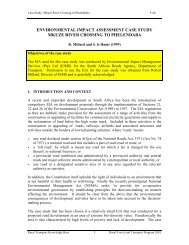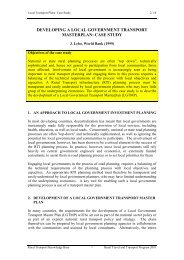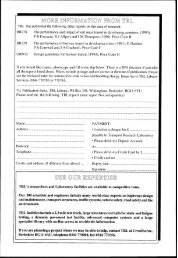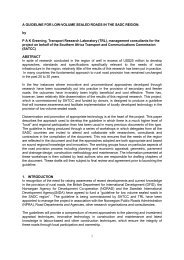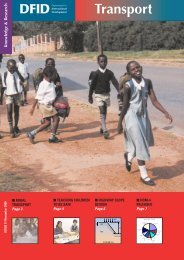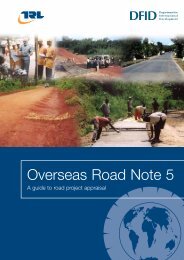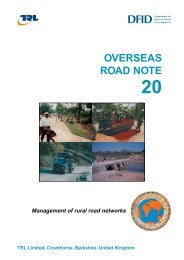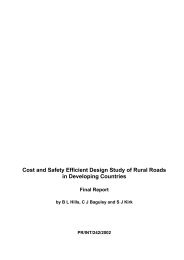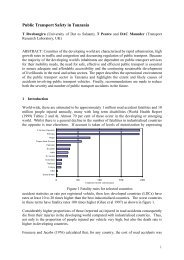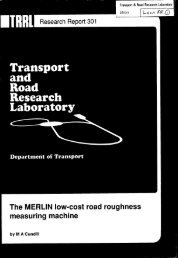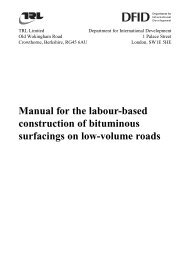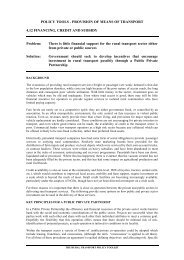Optimum axle loads of commercial vehicles in developing countries.
Optimum axle loads of commercial vehicles in developing countries.
Optimum axle loads of commercial vehicles in developing countries.
Create successful ePaper yourself
Turn your PDF publications into a flip-book with our unique Google optimized e-Paper software.
<strong>Optimum</strong> <strong>axle</strong> <strong>loads</strong> <strong>of</strong>evelop<strong>in</strong>g <strong>countries</strong>byJ. Rolt<strong>commercial</strong> <strong>vehicles</strong> <strong>in</strong>
TRANSPORT and ROAD .RESEARCH LABORATORYDepartment <strong>of</strong> the EnvironmentDepartment <strong>of</strong> TransportTRRL LABORATORY REPORT 1002OPTIMUM AXLE LOADS OF COMMERCIAL VEHICLESIN DEVELOPING COUNTRIESbyJ RoltBSC PhD M lnst HEThe work described <strong>in</strong> this Report forms pati <strong>of</strong> the programme @rried outfor the Overseas Development Adm<strong>in</strong>istration, but any views expressed arenot ne~ssarily those <strong>of</strong> the Adm<strong>in</strong>istrationOverseas UnitTransport and Road Research LaboratoryCrowthorne, Berkshire1981ISSN 0305–1 293
CONTENTSPageAbstract1. Introduction2. Method <strong>of</strong> analysis2,1 Introduction2.2 Factors <strong>in</strong>cluded <strong>in</strong> the analysis2.3 Method <strong>of</strong> computation – ma<strong>in</strong> series2.4 Method <strong>of</strong> computation – subsidiary series2,4.1 Terra<strong>in</strong> and subgrade2,4.2 Pavement damage relationship2.4.3 Price structure2.4.4 Vehicle wastage2.4.5 Construction poticy2.4.6 Type <strong>of</strong> vehicle2.4.7 Vehicle load condition2.4.8 Road ma<strong>in</strong>tenance poticy3. Road construction costs3.1 Pavement design3.2 Construction costs3.2.1 PartiMy loaded <strong>vehicles</strong>3.2.2 Increas<strong>in</strong>g ule load3.3 Stage construction costs4. Vehicle operat<strong>in</strong>g costs4.1 Introduction4.2 &neral results4.2.1 Vehicle wastage11333344445555566777788810
Page5.4,2.2 Vehicle load factor4.3 Total vehicle operat<strong>in</strong>g costsTotal transport costs5.1 New road construction101011115.1.1Wmumtotal transport costs115.1.25.1.35.1.45.1.5Terra<strong>in</strong> and subgradeVehicle load conditionVehicles with high pavement damage factorsPavement damage relationship121212126.7.8.9.5.2 Exist<strong>in</strong>g roads with strengthen<strong>in</strong>g overlays5.2.1 Price structure5.3 An example <strong>of</strong> mixed traffic on an exist<strong>in</strong>g road5.4 DscussionOther costs6.1 Introduction6,2 Bridges6.3 Accidents6.4 Ar pollution6.5 Noise and vibrationSummaryAchowledgementsReferences1213131314141516161617171810.Appendix 1:Input data for model3211.Appendix 2:Vehicle load<strong>in</strong>g characteristics35@CROWN COPYRIGHT 1981Extracts from the text may be reproduced,except for<strong>commercial</strong> purposes, provided the source is acknowledged
OPTIMUM ~LE LOADS OF COMMERCIAL VEHICLESIN DEVELOPING COUNTRIESme Road Transport Investment Model for develop<strong>in</strong>g <strong>countries</strong> has beenused to exam<strong>in</strong>e the effects <strong>of</strong> different tie load<strong>in</strong>g characteristics on: the totrd costs <strong>of</strong> road transport. It is shown that the sum <strong>of</strong> vehicleoperat<strong>in</strong>g costs, road construction costs and road ma<strong>in</strong>tenance andrehabfitation costs for a two lane highway irdtidy decrease rapidy asthe tie load <strong>of</strong> the most heady loaded <strong>vehicles</strong> <strong>in</strong>creases and passesthrough a sh~ow m<strong>in</strong>imum at the optimum tie load. ”The vrdue <strong>of</strong> this optimum Me load was found to be stron~ydependent on the total freight tonnages carried by the heavily loaded<strong>vehicles</strong>, the load condition <strong>of</strong> these <strong>vehicles</strong> on the return trip, theexponent <strong>of</strong> the pavement damage – tie load relationship, and therelative prices <strong>of</strong> the major components <strong>of</strong> road transport cost. Theoptimum tie load was found to be virtudy <strong>in</strong>dependent <strong>of</strong> the roadtignrnent and strength <strong>of</strong> the subgrade, but the road construction andstrengthen<strong>in</strong>g poticy and the composition <strong>of</strong> the vehicle fleet had asm~ but significant effect on ik value.It is shown that under most conditions there exists a traffic levelabove which the optimum tie load is above the current legal hrnits <strong>in</strong>force <strong>in</strong> most develop<strong>in</strong>g <strong>countries</strong>.me total road transport costs were usudy found to be relatively<strong>in</strong>sensitive to tie load <strong>in</strong> the region <strong>of</strong> the m<strong>in</strong>imum totrd trmsportcost, changes <strong>in</strong> tie <strong>loads</strong> <strong>of</strong> 10 per cent produc<strong>in</strong>g changes <strong>in</strong> thetransport costs <strong>of</strong> less than 1 per cent.1. INTRODUCTIONThe cost <strong>of</strong> operat<strong>in</strong>g a road transport system consists <strong>of</strong> two ma<strong>in</strong> components, namely the cost <strong>of</strong>operat<strong>in</strong>g the fleet <strong>of</strong> <strong>vehicles</strong> us<strong>in</strong>g the roads and the cost <strong>of</strong> construct<strong>in</strong>g and ma<strong>in</strong>ta<strong>in</strong><strong>in</strong>g the roadsthemselves. The cost <strong>of</strong> transport<strong>in</strong>g a particular tonnage <strong>of</strong> freight decreases quite rapidy as the amount<strong>of</strong> freight which each veticle carries <strong>in</strong>creases. ti the other hand the cost <strong>of</strong> provid<strong>in</strong>g and ma<strong>in</strong>ta<strong>in</strong><strong>in</strong>gthe roads <strong>in</strong>creases as vehicle tie <strong>loads</strong> <strong>in</strong>crease. The magnitude <strong>of</strong> these component costs and theirvariation with tie load ensures that under most circumstances the total cost <strong>of</strong> operat<strong>in</strong>g the transportsystem <strong>in</strong>itidy decreases as tie load <strong>in</strong>creases but passes through a m<strong>in</strong>imum value at the optimum tieload before <strong>in</strong>creas<strong>in</strong>g aga<strong>in</strong>. Most develop<strong>in</strong>g <strong>countries</strong> spend a large proportion <strong>of</strong> their”scarce resourceson road transport. It is therefore particularly desirable <strong>in</strong> such <strong>countries</strong> that the road transport systemshould operate under conditions which m<strong>in</strong>imise the total cost. This report discusses the relationship’between tie load and road transport costs <strong>in</strong> develop<strong>in</strong>g counties and considers the ‘optimum’ tie loadat which the total road transport costs are m<strong>in</strong>imised.i
The Iegd timits for We <strong>loads</strong> <strong>in</strong> <strong>in</strong>dustritised<strong>countries</strong> have <strong>in</strong>creased slowly over the last fewdecades, but untfl relatively recently the economic justification for changes <strong>in</strong> these legal timits has notbeen exam<strong>in</strong>ed very closely. Formerly the basic data were not avtiable to enable either the cost <strong>of</strong>operat<strong>in</strong>g the vehicle fleet to be calculated or the estimation <strong>of</strong> the additiond pavement damage causedby the heavier tie<strong>loads</strong> to be made. This has been partiy rectified as a result <strong>of</strong> the AASHO Road Test<strong>in</strong> which the damag<strong>in</strong>g effect <strong>of</strong> different tie<strong>loads</strong> on a variety <strong>of</strong> pavement structures was quantified.In addition severrdmajor studies2’3 <strong>of</strong> the factors which <strong>in</strong>fluence the cost <strong>of</strong> operat<strong>in</strong>g <strong>vehicles</strong> havebeen made and it is now possible to conduct <strong>in</strong>cremental analyses to show the economic effects <strong>of</strong> <strong>in</strong>creases<strong>in</strong> tie <strong>loads</strong>. Studies <strong>of</strong> this k<strong>in</strong>d have been made <strong>in</strong> several <strong>in</strong>dustriahed <strong>countries</strong>4’5 with the conclusionthat from a purely economic po<strong>in</strong>t <strong>of</strong> view, <strong>in</strong>creases <strong>in</strong> present led tie load timits are justified under atide variety <strong>of</strong> conditions.herica5For example <strong>in</strong> a study completed about ten years ago <strong>in</strong> the United States <strong>of</strong>it was found that if legrdafle weight timits throughout the country were <strong>in</strong>creased to 11.8 tonneson a s<strong>in</strong>~e tie and 20.0 tonnes on a tandem tie on au federd-aid highways the toti benefit-cost ratiowould be 12:1. To quote a recent report 6 ‘The magnitude <strong>of</strong> these figures was so stat<strong>in</strong>g and so contraryto the expectations <strong>of</strong> Mghway <strong>of</strong>ficiti that they were not reatiy accepted. A subsequent sensitivityanalysis and assessment <strong>of</strong> the calculations <strong>in</strong>dicated that the benefit-cost ratios were <strong>of</strong> such a magnitudeas to be <strong>in</strong>sensitive to any reasonable comb<strong>in</strong>ation <strong>of</strong> possible errors’.The legal tirnits for de<strong>loads</strong> <strong>in</strong> develop<strong>in</strong>g <strong>countries</strong> differ widely from country to country rang<strong>in</strong>gfrom 4 tonnes to 13 tonnes on a s<strong>in</strong>@etie and from 8 tonnes to 20 tonnes on a tandem tie. Indeed some<strong>countries</strong> have no legal limit on tie <strong>loads</strong> at W. To some extent these Wts reflect the differentenvironmental and social conditions <strong>of</strong> each country but econoticto justify them.analyses have rarely, if ever, been usedIn many develop<strong>in</strong>g <strong>countries</strong> <strong>vehicles</strong> are <strong>of</strong>ten loaded above the Iegd load tirnits. In tiecarried out <strong>in</strong> various <strong>countries</strong> 78 ‘ , It . has been found that up to 70 per cent <strong>of</strong> <strong>commercial</strong> <strong>vehicles</strong> areload surveysoverloaded <strong>in</strong> this way, a typical figure be<strong>in</strong>g about 30 per cent. Not ody are the number, <strong>of</strong> <strong>vehicles</strong> whichare overloaded large but the magnitude <strong>of</strong> the overload<strong>in</strong>g is high. For example it has been shown that onone trunk road <strong>in</strong> Kenya the merage equivalence factor for comercird <strong>vehicles</strong> is over five times the valuewtich would be obta<strong>in</strong>ed if the <strong>vehicles</strong> were loaded to the current legal hmits. Mthough the damag<strong>in</strong>geffect <strong>of</strong> these heatiy loaded <strong>vehicles</strong> on the pavement has been appreciated the over~ economic consequence<strong>of</strong> operat<strong>in</strong>g heavy <strong>vehicles</strong> with high tie <strong>loads</strong> has rarely been exam<strong>in</strong>ed. h particular tie relationshipbetween the optimum tie load, the legal tie load hmits and the spectrum <strong>of</strong> observed tie <strong>loads</strong> has notbeen studied <strong>in</strong> dettifor a develop<strong>in</strong>g country.Recogniz<strong>in</strong>gthe magnitude <strong>of</strong> the benefits which can arise from operat<strong>in</strong>g the road transport systemunder conditions which give rise to a m<strong>in</strong>imum total cost, some develop<strong>in</strong>g <strong>countries</strong> are now attempt<strong>in</strong>gto rationtise the operation <strong>of</strong> heir road transport system. An important step <strong>in</strong> this process is the selection<strong>of</strong> legal hrnits for de <strong>loads</strong>. This report Nustrates how the Road Transport Investment Modelg can be usedto calculate the costs and benefits associated with different atie <strong>loads</strong>. The ma<strong>in</strong> factors which affect thevalue <strong>of</strong> the optimum tieload are identified and the sensitivity <strong>of</strong> the optimum to changes <strong>in</strong> these factorsk exam<strong>in</strong>ed. It is shown that under most conditions higher legal afle load tirnits than are currentiy <strong>in</strong> forceh most develop<strong>in</strong>g <strong>countries</strong> are justified for a given vehicle fleet and the magnitude <strong>of</strong> the benefits whichwould be forgone if exist<strong>in</strong>g led fimits were genu<strong>in</strong>ely enforced is very large <strong>in</strong>deed. This conclusion appfieswhether new road construction or the strengthen<strong>in</strong>g <strong>of</strong> an exist<strong>in</strong>g road network is considered.2
2. METHOD OF ANALYSIS2.1 IntrodutiionTo appreciate the relative irnportmce <strong>of</strong> the variables which affect the optimum atie load for a trunkroad <strong>in</strong> a develop<strong>in</strong>g country and the <strong>in</strong>teractions between them, the actual situation was <strong>in</strong>iti~y simphfied.As the atiysis proceeded these simplifications were removed until f<strong>in</strong>~y an example <strong>of</strong> a completeanalysis for a trunk road <strong>in</strong> a develop<strong>in</strong>g country is presented. No attempt has been made to conduct anrmdysis for the road network <strong>of</strong> an entire country for the reasons outhned <strong>in</strong> Section 6.1.InitiWy it was assumed that W the freight is transported by a fleet consist<strong>in</strong>g <strong>of</strong> one type <strong>of</strong> vehicleand that d the <strong>vehicles</strong> are loaded to the particular tie load under consideration. The total transport costsfor this simphfied situation were then calculated for a particular total freight tonnage carried over a fifteenyear atiysis period. The calculations were then repeated for different tie <strong>loads</strong> to determ<strong>in</strong>e the t<strong>in</strong>imumtotal costs and the correspond<strong>in</strong>g optimum afle load. This complete series <strong>of</strong> calculations was thenrepeated for different total freight tonnage rang<strong>in</strong>g from 0.5 to 10.0 tihonthen performed to show how the m<strong>in</strong>imum total costs and optimum tietonnes. Further analyses were<strong>loads</strong> depend on the othervariables discussed below. The calculations themselves were d performed us<strong>in</strong>g the Road TransportInvestment Model for develop<strong>in</strong>g <strong>countries</strong> (RTIM) wtich is described <strong>in</strong> detti elsewhere’ 1‘.2.2 Fa~ors <strong>in</strong>cluded <strong>in</strong> the analysisfactors.The analysis was designed to show how the optimum tieload depends on the follow<strong>in</strong>g pr<strong>in</strong>cipal1)2)3)4)5)6)7)8)9)1o)Total freight tonnage carried.Terra<strong>in</strong> and road ahgnment.Subgrade strength.Pavement damage relationship.Relative prices <strong>of</strong> the major components <strong>of</strong> road transport costs.Veticle waitage or wear rates.Stage construction p<strong>of</strong>icy for the pavement.Type <strong>of</strong> vehicle and afle configuration.Vehicle load condition.Road ma<strong>in</strong>tenance poticy.2.3 Method <strong>of</strong> amputation – ma<strong>in</strong> seriesThe computational procedure is outt<strong>in</strong>ed <strong>in</strong> Figure 1. In this section <strong>of</strong> the report the ranges <strong>of</strong> thevarious parameters <strong>in</strong>cluded <strong>in</strong> the analysis are described.The ma<strong>in</strong> series <strong>of</strong> calculations is def<strong>in</strong>ed by loops 1 and 2 <strong>in</strong> Figure 1. At the beg<strong>in</strong>n<strong>in</strong>g <strong>of</strong> loop 1the vehicle type or types have already been chosen and once the freight tonnage and rear atie load havedso been selected the total number <strong>of</strong> vehicle trips can be calculated (Section 2.4.7). It was assumedthroughout this study that the growth rate <strong>of</strong> traffic (or freight) was constant at 5 per cent per year.Us<strong>in</strong>g this assumption the first year average dtiy traffic was calculated as required by the model <strong>in</strong>put.Next the pavement was designed, accord<strong>in</strong>g to the selected construction policy, us<strong>in</strong>g established pavementdesign procedures as described <strong>in</strong> Section 3.1. F<strong>in</strong>dy the Road Transport hvestment Model was run to3
obta<strong>in</strong> the road construction costs, vehicle operat<strong>in</strong>g costs and road ma<strong>in</strong>tenance costs. The rear tie load<strong>of</strong> the <strong>vehicles</strong> was then changed keep<strong>in</strong>g the total freight tonnage constant and the sequence <strong>of</strong> operationsrepeated. For tandem Wes the totil rear afle load on the pair <strong>of</strong> ties was varied from 6 tonnes up to32 tonnes and for s<strong>in</strong>#e afles from 4 tonnes up to 16 tonnes. The sequence <strong>of</strong> loop 1 was then repeatedfor different total freight tonnages (loop 2) and the results plotted as a series <strong>of</strong> graphs show<strong>in</strong>g, for eachfreight tonnage, the dependence on rear tie load <strong>of</strong>a) Vehicle operat<strong>in</strong>g costs.b) Road construction and ma<strong>in</strong>tenance costs.c) Total transport costs.Graphs <strong>of</strong> this k<strong>in</strong>d were produced for the complete range <strong>of</strong> the variables discussed <strong>in</strong> the f<strong>of</strong>low<strong>in</strong>g sections.The model <strong>in</strong>put data are summarised <strong>in</strong> Appendix 1.2.4 Method <strong>of</strong> amputation - subsidiary series2.4.1 Terra<strong>in</strong> and subgrade. Three types <strong>of</strong> terra<strong>in</strong> were selected namely flat, ro~ng and My andthree vrdues<strong>of</strong> subgrade strength, def<strong>in</strong>ed by CBR values <strong>of</strong> 3, 7 and 15 per cent. The vertical tignment<strong>of</strong> the roads <strong>in</strong> the three terra<strong>in</strong> areas is shown <strong>in</strong> Appendix 1.The ody costs which are <strong>of</strong> <strong>in</strong>terest <strong>in</strong> this analysis are those which depend on the load imposed bythe ma<strong>in</strong> load-bear<strong>in</strong>g ties <strong>of</strong> the <strong>vehicles</strong>. Thus the pr<strong>in</strong>cipal effect <strong>of</strong> the road tignment is on the vehicleoperat<strong>in</strong>g costs which depend <strong>in</strong> a complex manner on vehicle weight and road geometry. The subgradestrength directly <strong>in</strong>fluences the structural design <strong>of</strong> the pavement which is extremely dependent on thetile <strong>loads</strong> imposed. The costs <strong>of</strong> the additiond earthworks associated with the rolhng and hi~y terra<strong>in</strong>are <strong>in</strong>dependent <strong>of</strong> afle load.2.4.2 Pavement damage relationship. The structural damage to a pavement caused by static wheel<strong>loads</strong> is given by an empirical equation <strong>of</strong> the fo~ow<strong>in</strong>g form:(Pavement damage) a (tieload)nThe value <strong>of</strong> the exponent, n, is genera~y taken to be about 4.5 but there is considerable uncerta<strong>in</strong>tyas to its exact value under different conditions. A partial reanalysis <strong>of</strong> the AASHO Road Testl is given <strong>in</strong>Reference 11 where it is shown that n can vary from 2.4 up to 6.6 under extreme conditions.It was concluded that. for heavy wheel <strong>loads</strong> on roads <strong>of</strong> medium or high strength, as measured by thestructural number, the vahre <strong>of</strong> n was <strong>in</strong> the range 3.2–5.6. In this study a value <strong>of</strong> 4.5 has been used formost <strong>of</strong> the calculations but a value <strong>of</strong> 6.0 has also been used to exaf<strong>in</strong>e the sensitivity <strong>of</strong> the results to thevalue <strong>of</strong> this exponent.2.4.3 Price strutiure. Both the vehicle operat<strong>in</strong>g costs and pavement structural costs are stron~ydependent on the cost <strong>of</strong> products derived from crude od. In recent years these costs have risen rapidy<strong>in</strong> red terms hence the sensitivity <strong>of</strong> the value <strong>of</strong> the optimum tie load to the price structure, <strong>in</strong> particularthe price <strong>of</strong> petrol and bitumen, has been exam<strong>in</strong>ed. Ody two alternatives were studied namely the priceswhich appheJ <strong>in</strong> Kenya two years before and one yew after the large rise <strong>in</strong> the price <strong>of</strong> crude oil whichtook place <strong>in</strong> 1974. Details <strong>of</strong> the prices used <strong>in</strong> the analysis are conta<strong>in</strong>ed <strong>in</strong> Appendix 1.4
2.4.4 Vehicle wastage. Vehicle operat<strong>in</strong>g cost data were collected for the fleet <strong>of</strong> <strong>vehicles</strong> operat<strong>in</strong>g<strong>in</strong> Kenya as part <strong>of</strong> the study which lead to the production <strong>of</strong> the Road Transport Investment Mode13.In Kenya, as <strong>in</strong> most develop<strong>in</strong>g <strong>countries</strong>, <strong>vehicles</strong> are <strong>of</strong>ten heavily overloaded hence the vehicle operat<strong>in</strong>gcosts which were obta<strong>in</strong>ed <strong>in</strong>cluded data from <strong>vehicles</strong> which were habitually operated <strong>in</strong> this state.However data on the average work<strong>in</strong>g lives <strong>of</strong> <strong>vehicles</strong> were not obta<strong>in</strong>ed directly from the operators henceit was not possible to identify the dependence, if any, <strong>of</strong> this factor on vehicle load. To study the effect <strong>of</strong>reduc<strong>in</strong>g the average tife <strong>of</strong> <strong>vehicles</strong> the vehicle wastage equations <strong>in</strong> the model were changed to reduce theaverage life by 25 per cent, thus <strong>in</strong>creas<strong>in</strong>g the vehicle operat<strong>in</strong>g costs.2.4.5 Construction policy. Two types <strong>of</strong> road construction policy were used. In the first policy theroad was designed to carry the total traffic throughout the fifteen year analysis period without the needfor additiond pavement strengthen<strong>in</strong>g.In the second policy the road was designed to carry the trafficexpected dur<strong>in</strong>g the analysis period assum<strong>in</strong>g that the ade load fimit was 8 tonnes on a s<strong>in</strong>~e <strong>axle</strong> and16 tonnes on a tandem afle. In these calculations as the <strong>axle</strong> load <strong>in</strong>creased the total traffic load expressed<strong>in</strong> equivalent standard <strong>axle</strong>s also <strong>in</strong>creased although the number <strong>of</strong> vehicle trips needed to transport a givenfreight tonnage decreased. ~us the road needed strengthen<strong>in</strong>g at least once dur<strong>in</strong>g the analysis period.Strengthen<strong>in</strong>g overlays were applied whenever the road reached a ‘failure’ condition.Road ‘fatiure’ is def<strong>in</strong>ed <strong>in</strong> RTIM by a critical level <strong>of</strong> roughness and s<strong>in</strong>ce roughness has a considerable<strong>in</strong>fluence on vehicle operat<strong>in</strong>g costs it was important to ensure that <strong>in</strong> all runs <strong>of</strong> the model for which aparticular ma<strong>in</strong>tenance policy was <strong>in</strong> use au <strong>vehicles</strong> experienced the same average roughness values. Thiswas achieved by choos<strong>in</strong>g the design thickness <strong>of</strong> the road or the thickness <strong>of</strong> strengthen<strong>in</strong>g overlays <strong>in</strong>such a wzy that the pavement reached the ‘faflure’condition at the end <strong>of</strong> the analysis period. Thismethod also ensured that the residual economic value <strong>of</strong> the road at the end <strong>of</strong> the analysis period wasalways the same and therefore did not need to be calculated.2.4.6 Type <strong>of</strong> vehicle. Various types <strong>of</strong> vehicle were used <strong>in</strong> the analysis together with mixed vehiclefleets. The characteristics <strong>of</strong> these <strong>vehicles</strong> are based on the results <strong>of</strong> several afle load surveys conducted<strong>in</strong> Kenya7. ~assifications <strong>of</strong> <strong>vehicles</strong> based on afle configuration and udaden weight were used to def<strong>in</strong>etypical <strong>vehicles</strong>, details <strong>of</strong> which are given <strong>in</strong> Appendix 2. For each type <strong>of</strong> vehicle the relationship betweentieload and payload and between afle load and pavement damage expressed <strong>in</strong> equivalent standard tiesare known from the survey data. Us<strong>in</strong>g the first <strong>of</strong> these relationships the payload can be found for anygiven afle load and hence the total number <strong>of</strong> vehicle trips required to carry the selected freight tonnagecan be found. Us<strong>in</strong>g this result the second relationship can be used to calculate the total number <strong>of</strong> ‘standard ades for which the road must be designed.2.4.7 Vehicle load condition. The average cost <strong>of</strong> transport<strong>in</strong>g each tonne <strong>of</strong> freight depends on thelevel.<strong>of</strong> vehicle utifisation. For <strong>vehicles</strong> which are <strong>of</strong> <strong>in</strong>terest <strong>in</strong> this study, namely those able to make use<strong>of</strong> the maximum allowed ade load, two extreme conditions were exam<strong>in</strong>ed. In the first condition, herectied the fu~ load condition, the <strong>vehicles</strong> were fufly loaded <strong>in</strong> both the outward and return directions. Inthe second or half-load condition the <strong>vehicles</strong> were fully loaded <strong>in</strong> one direction and empty <strong>in</strong> the other.2,4.8 Road ma<strong>in</strong>tenance policy. The options <strong>in</strong> the model allow different road patch<strong>in</strong>g and surfacedress<strong>in</strong>g pohcies to be adopted. The effect <strong>of</strong> these different policies on the total costs was ne~igible <strong>in</strong>comparison with the different costs <strong>of</strong> the stage construction pohcies and is not discussed further.5
3. ROAD CONSTRUCTION COSTS3.1 Pavement designThe relationship between the modified structural number <strong>of</strong> a pavement and its traffic carry<strong>in</strong>gcapacity which is used <strong>in</strong> the model is an extension <strong>of</strong> Road Note 31 12!13. The total thickness <strong>of</strong> pavementis always less than that recommended <strong>in</strong> the design curves <strong>of</strong> Road Note 29 14 but the tfickness differenceis almost constant hence both design curves give the same variation <strong>in</strong> thickness, and therefore constructioncosts, with ade load. The road structure assumed consists <strong>of</strong> a cement stabilised sub-base, a crushed stonebase and a bitum<strong>in</strong>ous surfac<strong>in</strong>g.Comparisons <strong>of</strong> thickness design charts has shown that the def<strong>in</strong>ed term<strong>in</strong>al condition <strong>of</strong> a road has amajor <strong>in</strong>fluence on the recommended pavement thicknesses. Thus although a design based on Road Note 29does not alter the variation <strong>in</strong> pavement costs with afle load it does affect the vehicle operat<strong>in</strong>g costs throughthe’<strong>in</strong>fluence <strong>of</strong> road surface condition and could therefore affect the optimum afle load. By ensur<strong>in</strong>gthat the average roughness experienced by dl <strong>vehicles</strong> <strong>in</strong> a series <strong>of</strong> model runs is always the same, theeffect <strong>of</strong> roughness on vehicle operat<strong>in</strong>g costs is dso the same and therefore not dependent on afle load.This is guaranteed by ensur<strong>in</strong>g that the road reaches the term<strong>in</strong>al condition at the end <strong>of</strong> the analysis period.[t can be shown from most pavement design charts that the traffic carry<strong>in</strong>g capacity <strong>of</strong> a road isrelated to the structural number 1 by an equation <strong>of</strong> the form:Traffic Carry<strong>in</strong>g Capacity a (Structural Number)mThe value <strong>of</strong> the parameter ‘m’obta<strong>in</strong>ed from the AASHTO design charts 15, which recommendlarger values <strong>of</strong> structural number than most design charts <strong>in</strong> current use, is approximately 6.3; for otherdesign charts ‘m’ is greater than 6.3. In general “fora low traffic design (less than 2.5 mi~ion standard ties)the value <strong>of</strong> ‘m’is greater than for a high traffic design. In the design chart used here ‘m’varies from 10.0for low traffic to about 7.5 for high traffic (more than 10.0 million standard ties).If this equation isconsidered together with the pavement damage equation above it can be seen that an <strong>in</strong>crease <strong>in</strong> structuralnumber <strong>of</strong> 15 per cent <strong>in</strong>creases the traffic carry<strong>in</strong>g capacity by about 200 per cent. This is equivalent toan <strong>in</strong>crease <strong>in</strong> s<strong>in</strong>$e <strong>axle</strong> load from 8.0 tonnes to just over 10.0 tonnes even assum<strong>in</strong>g the number <strong>of</strong> vehicletrips rema<strong>in</strong>s unaltered. A 15 per cent <strong>in</strong>crease <strong>in</strong> structural number is also equivalent to an <strong>in</strong>crease <strong>in</strong>pavement costs <strong>of</strong> about 15 per cent (Section 3.2) and an <strong>in</strong>crease <strong>in</strong> total construction costs <strong>of</strong> considerablyless than this. This example illustrates the extreme importance <strong>of</strong> the power <strong>in</strong>dices <strong>in</strong> the above equations.Unfortunately the only systematic study <strong>of</strong> the relative damag<strong>in</strong>g effects <strong>of</strong> different <strong>axle</strong> <strong>loads</strong> wasundertaken dur<strong>in</strong>g the AASHO Road Test. The conclusions bf this study have been criticised for a variety<strong>of</strong> reasons but pr<strong>in</strong>cipally because (a) the test was conducted on only one type <strong>of</strong> subgrade, (b) much <strong>of</strong>the pavement deterioration occurred dur<strong>in</strong>g the spr<strong>in</strong>g thaw mak<strong>in</strong>g it difficult to isolate the deteriorationwhich took place dur<strong>in</strong>g the dry, warm periods <strong>of</strong> the year and (c) the study was an accelerated test lead<strong>in</strong>gto road fadure with<strong>in</strong> two years. Nevertheless this is the ody full scale study from which it has beenpossible to derive a relationship between <strong>axle</strong> load and pavement deterioration and therefore the resultsare widely used.In this study the traffic has been def<strong>in</strong>ed by the equivalent number <strong>of</strong> standard afles calculated byus<strong>in</strong>g either the standard 4.5 power law approximation to Liddle’s orig<strong>in</strong>al equation developed dur<strong>in</strong>g theAASHO Road Test or by us<strong>in</strong>g a 6.0 power law as described <strong>in</strong> Section 2.4.2 above.6
3.2 Construtiion costsThe unit costs used <strong>in</strong> the construction submodel <strong>of</strong> RTIM are shown <strong>in</strong> Appendix 1. The results <strong>of</strong>the model runs show that the cost <strong>of</strong> construction is hnearly dependent on the structural number providedthe structural number, SN, is above the lower hmit<strong>in</strong>g value SNO. The costs can be expressed as follows:Costs = a t (b x SN),SN > SNOwhere the constant ‘a’depends pr<strong>in</strong>cipally on the vertical geometry and therefore the quantity <strong>of</strong>earthworks but not on SN, the constant ‘b’is <strong>in</strong>dependent <strong>of</strong> vertical geometry and SNOis the value <strong>of</strong> SNwhich is required for the lowest traffic levels.3.2.1 Partially loaded <strong>vehicles</strong>. Fi~re 2 shows the cost <strong>of</strong> construct<strong>in</strong>g a road <strong>in</strong> ro~<strong>in</strong>g terra<strong>in</strong> on asubgrade with a design CBR <strong>of</strong> 3 per cent as a function <strong>of</strong> traffic. The curve <strong>in</strong>dicates that the marg<strong>in</strong>alcost <strong>of</strong> construction decreases quite quictiy as the design traffic <strong>in</strong>creases. The importance <strong>of</strong> thisbecomes apparent when the traffic which does not <strong>in</strong>crease its tie load <strong>in</strong> accordance with the <strong>in</strong>creas<strong>in</strong>ghmits is taken <strong>in</strong>to account. Generally throughout this study it has been assumed that all the <strong>vehicles</strong>make full use <strong>of</strong> the <strong>axle</strong> load hrnits imposed. Certa<strong>in</strong>ly the results <strong>of</strong> tie load surveys <strong>in</strong> develop<strong>in</strong>g<strong>countries</strong> has shown that overload<strong>in</strong>g above the legal hmits is so frequent and <strong>of</strong> such a magnitude thatvirtually dl pavement damage is <strong>of</strong>ten attributable to these <strong>vehicles</strong>. The effect <strong>of</strong> <strong>vehicles</strong> which do notmake use <strong>of</strong> the afle load hmits under consideration is tw<strong>of</strong>old. The effect on the total vehicle operat<strong>in</strong>gcosts as tie load <strong>in</strong>creases is constant s<strong>in</strong>ce no changes take place to these vehicies but the effect on pavementconstruction costs is not constant. The graph shows that when the atie load tirnit is low and the totalconstruction costs are dso low the marg<strong>in</strong>al cost <strong>of</strong> design for the partly loaded <strong>vehicles</strong> is high whereaswhen the afle load hmit is raised the total construction costs are also raised but the marg<strong>in</strong>al cost <strong>of</strong> designfor the partly loaded <strong>vehicles</strong> decreases. The effect <strong>of</strong> this on the relationship between road constructioncosts and tie load is to flatten the ris<strong>in</strong>g curve and thereby to <strong>in</strong>crease the optimum ade load.3.2.2 Increas<strong>in</strong>g <strong>axle</strong> load. The results <strong>of</strong> a series <strong>of</strong> runs <strong>of</strong> the model show<strong>in</strong>g the relationshipbetween construction costs, ade load, and total freight tonnage are shown <strong>in</strong> Figure 3. The effect <strong>of</strong> thedifferent terra<strong>in</strong> categories is simply to raise or lower the cost curves by fixed amounts depend<strong>in</strong>g on thedifferences <strong>in</strong> the fixed earthworks costs.3.3 Stage mnstru~ion restsThe relationship between the cost <strong>of</strong> structural overlays and traffic is similar <strong>in</strong> shape to Figure 2. Anexample <strong>of</strong> such a relationship is shown <strong>in</strong> Figure 4 for a road witi an <strong>in</strong>itial structural number <strong>of</strong> 3.05.The costs shown are the sum <strong>of</strong> normal ma<strong>in</strong>tenance costs and overlay costs. Indicated on the graph are thepo<strong>in</strong>ts correspond<strong>in</strong>g to various thicknesses <strong>of</strong> overlay and the number <strong>of</strong> overlays which have been apptieddur<strong>in</strong>g the analysis period. Various rdternative poticies are possible witlr<strong>in</strong> the constra<strong>in</strong>ts <strong>of</strong> the assumptions.~enever the number <strong>of</strong> overlays required is greater than one t!~ereare rdways poticies available whichrequire thicker but less frequent overlays. These poticies will usua~y be more expensive as a result <strong>of</strong> thediscount procedure built <strong>in</strong>to the model.The ma<strong>in</strong>tenance costs themselves exclud<strong>in</strong>g the cost <strong>of</strong> overlays are smti and m2ny <strong>of</strong> thecomponent costs <strong>of</strong> ma<strong>in</strong>tenance are <strong>in</strong>dependent <strong>of</strong> tie load. The costs <strong>of</strong> patch<strong>in</strong>g failed areas <strong>of</strong> pavementand the costs <strong>of</strong> surface dress<strong>in</strong>g are crdculated <strong>in</strong> the model and <strong>in</strong>cluded <strong>in</strong> the total cost summations butare not andysed <strong>in</strong> detafl.7
4. VEHICLE OPERATING COSTS4.1 IntrodutiionThe estimation <strong>of</strong> vehicle operat<strong>in</strong>g costs with<strong>in</strong> the model is based on the results <strong>of</strong> studies carriedout <strong>in</strong> Kenya, Ethiopia and elsewhere9’13. Data were co~ected <strong>in</strong> terms <strong>of</strong> quantities rather than pricesso that the model user is able to apply up to date prices <strong>in</strong> his calculations.Two sets <strong>of</strong> <strong>in</strong>put cost data were used <strong>in</strong> this study. These are summarised <strong>in</strong> Appentito Kenyan conditions.1 and apply4.2 General resultsTables 1 and 2 show typical vehicle operat<strong>in</strong>g cost components. Table 1 shows that although theprice <strong>of</strong> fuel <strong>in</strong>creased by more than 100 per cent between 1972 and 1975 the total costs <strong>in</strong>creasedby 63 per cent. In this example the proportion <strong>of</strong> total costs attributable to fuel thereby <strong>in</strong>creased from10.0 per cent to 12.4 per cent. Table 2 illustrates how sensitive the costs per tonne payload are to the tieload selected. Detded comparisons <strong>of</strong> the vehicle operat<strong>in</strong>g cost components obta<strong>in</strong>ed us<strong>in</strong>g the modeltith the results <strong>of</strong> other studies have been discussed elsewhere3.TABLE 1Effect <strong>of</strong> price structure on vehicle operat<strong>in</strong>g costs(Prices expressed <strong>in</strong> Kenyan s~ngs per b)VeMcle type 3 tieUdaden wei~t 7.5 toMesBHP 177Road roughness 3,000 mm/hAnnual tiometrage 75,000had conditionPayload (tonnes)1972FuU11.6%1975Futi11.6%1975, 1975FuelOilSparesW<strong>in</strong>tenanceTyresDepreciationInterestCrew wagesOverheads0.340.020.710.410.330.210.110.600.6810.00.620.812.09.76.23.217.620.00.690.041.260.540.490.430.200.801.1112.40.722.79.78.87.73.614.420.00.77 0.540.04 0.041.26 1.26 ‘0.54 0.540.61 0.390.43 0.430.20 0.200.80 0.801.16 1.05DTotalTotal/tonne h3.410.2945.550.4695.80 5.250.356 0.6448
TABLE 2Typical vehicle operat<strong>in</strong>g costs(1975 prices expressed <strong>in</strong> Kenyan shilf<strong>in</strong>gs per km)Vehicle typeUnladen weightBHP2 ade5.5 tonnes150Road rou~ess 3000 mm/km ,Annual kilometrage 75,000Rear <strong>axle</strong> (tonnes)Payload (tonnes)5.02.07.05.09.07.410,08.811.010.012.011.2FueloilSparesMa<strong>in</strong>tenanceTyresDepreciationInterestCrew wagesOverheadsTOTALTOTAL/TONNE0.390.041.160.540.190.390.190.800.934.632.310.500.041.160.540.270.390.190.800.974.860.9720.570.041.160.540.330.390.190.801.004.970.6720.600.041.160.540.370.390.190.801.015.100.5800.630.041.160.540.400.390.190.801.035.130.5130.650.041.160.540.430.390.190.801.055.250.469Vehicle type 3 <strong>axle</strong>Unladen weight 7.5 tonnesBHP 177Rear afle (tonnes) 1 10.0 14.0Payload (tOMW) 6.8 11.6Fuel 0.59 0.69oil 0.04 0.04Spares 1.26 1.26Ma<strong>in</strong>tenance 0.54 0.54Tyres 0.37 0.49Depreciation 0.43 0.43Interest 0.20 0.20Crew wagea 0.80 0.80Overheads 1.05 1.11TOTAL 5.27 5.55TOTAL/TONNE 0.775 0.479Road roughness 3000 mm/kmAnnual kilometrage 75,00018.0 20.0 22.016.3 18.7 21.10.770.041.260.540.610.430.200.801.165.800.3560.810.041.260.540.670.430.200.801.195.930.3170.850.041.260.540.730.430.200.801.216.050.28724.023.50.880.041.260.540.800.430.200.801.236.170.263Vehicle type 3 tie + 2 tie trailerUrdaden weight 12.0 tonnesBHP 177Rear afle (tonnes)Payload (tonnes)FueloilSparesMa<strong>in</strong>tenanceTyresDepreciationInterestCrew wagesOverheadsTOTA.LTOTAL/TONNE10.012.30.780.041.570.540.620.530.250.801.296.430.52314.021.1O.gl0.041.570.540.850.530.250.801.376.870.326Road roughness 3000 mm/kmAnnual tiomctrage 75,00018.0 20.029.8 34.21.020.041.570.541.070.530.250.801.467.280.2441.070.041.570.541.190.530.250.801.507.490.21922.038.61.110.041.570.541.300.530.250.801.547.690.19924.043.01.160.041.570.541.410.530.250.801.587.890.1839
4.2.1 Vehicle wastage. Vehicle wastage is taken <strong>in</strong>to account <strong>in</strong> the model as part <strong>of</strong> depreciationcosts. Table 1 shows that depreciation costs are less than 8 per cent <strong>of</strong> total vehicle operat<strong>in</strong>g costs andhence total costs are not very sensitive to this factor. The difference <strong>in</strong> vehicle operat<strong>in</strong>g costs when thehigh wastage equations were used was always less than 2 per cent and made no significant difference to theresult<strong>in</strong>g optimum <strong>axle</strong> load,4.2.2 Vehicle load factor. Table 2 <strong>in</strong>dicates that for the example shown vehicle operat<strong>in</strong>g costs pertonne <strong>of</strong> payload for the half load condition are <strong>in</strong>creased by about 80 per cent over the full load condition.This figure <strong>in</strong>creases to nearly 100 per cent for low values <strong>of</strong> a~e load, as might be expected.4.3 Total vehicle operat<strong>in</strong>g costsThe dependence <strong>of</strong> total vehicle operat<strong>in</strong>g costs per tonne kilometre on gross vehicle weight isi~ustrated for three types <strong>of</strong> vehicle <strong>in</strong> Figure 5. These costs are total runn<strong>in</strong>g costs plus stand<strong>in</strong>g chargesfor the vehicle <strong>in</strong> question but do not <strong>in</strong>clude costs associated with load<strong>in</strong>g and urdoad<strong>in</strong>g. It is assumedthat these latter costs are dependent only on payload and can therefore be expressed as an extra cost pertonne. Naturally this will vary for different types <strong>of</strong> cargo but for any particular cargo it is assumedconstant and therefore cannot affect the optimum afle load.Detafled comparisons with veticle operat<strong>in</strong>g costs obta<strong>in</strong>ed <strong>in</strong> other studies have proved difficultfor several reasons. Firstly the operat<strong>in</strong>g conditions <strong>in</strong> developed <strong>countries</strong> where dl the comprehensivestudies have taken place are quite different. For example the cost components which are <strong>of</strong> <strong>in</strong>terest <strong>in</strong>this study, namely those which depend on vehicle load condition, represent a completely differentproportion <strong>of</strong> total runt<strong>in</strong>g costs. Furthermore there are no other studies <strong>in</strong> which the relationshipbetween these costs, expressed <strong>in</strong> terms <strong>of</strong> costs per vehicle kilometre, and vehicle load condition has beenisolated. Costs are usually expressed as average costs per tonne kilometre for different types <strong>of</strong> <strong>vehicles</strong>obta<strong>in</strong>ed under average load conditions.The decrease <strong>in</strong> costs with gross vehicle weight thereforerepresents a mixture <strong>of</strong> effects. First <strong>of</strong> all the decrease <strong>in</strong> costs per tonne is attributable to the <strong>in</strong>creasedload factor even though the average trip cost is assumed to be the same. Secondly as the gross vehicleweight <strong>in</strong>creases so generally does the size <strong>of</strong> vehicle used <strong>in</strong> the calculations. Thus the basic relationshipbetween the cost <strong>of</strong> a vehicle-kilometre and the payload (or gross vehicle weight) for a particular type <strong>of</strong>vehicle cannot be obta<strong>in</strong>ed. A further major disadvantage <strong>of</strong> other studies is that costs are usually obta<strong>in</strong>ed<strong>in</strong> money terms with the result that they are soon out <strong>of</strong> date. In the Road Transport Investment Modelquantities are used where possible for dl the components <strong>of</strong> vehicle operat<strong>in</strong>g costs. Thus different pricestructures can be used to assessthe effects <strong>of</strong>, for example, the rise <strong>in</strong> price <strong>of</strong> any component cost.F<strong>in</strong>ally it is not always clear <strong>in</strong> reports <strong>of</strong> other studies which <strong>of</strong> the component costs have been <strong>in</strong>cludedand which excluded from the total vehicle operat<strong>in</strong>g costs. In particular the treatment <strong>of</strong> <strong>in</strong>terest charges,depreciation and crew wages <strong>of</strong>ten varies from author to author.Despite these difficulties a comparison between a sample <strong>of</strong> the vehicle operat<strong>in</strong>g costs used <strong>in</strong> thisstudy and several other studies is shown <strong>in</strong> Figure 6. The data have all been norrnafised to the vehicleoperat<strong>in</strong>g costs obta<strong>in</strong>ed for a vehicle <strong>of</strong> 14 tonnes gross vehicle weight. The data for this figure wereobta<strong>in</strong>ed from Figure 5 by draw<strong>in</strong>g a smooth curve through the lowest sections <strong>of</strong> the three separate curvesrepresent<strong>in</strong>g the 2-<strong>axle</strong>d vehicle, the 3-<strong>axle</strong>d vehicle and the 5-<strong>axle</strong>d vehicle trtier comb<strong>in</strong>ation <strong>in</strong> the fullload condition. This is the same approach used by the other authors and represents a sensible choice <strong>of</strong>vehicle by the vehicle operators. It would be expected that s<strong>in</strong>ce many operators <strong>in</strong> develop<strong>in</strong>g <strong>countries</strong>overload their <strong>vehicles</strong> the change over between vehicle sizes would take place further along the gross10
vehicle weight scale result<strong>in</strong>g <strong>in</strong> lower costs per tonne payload <strong>in</strong> comparison with the studies conducted<strong>in</strong> Sweden16 and the USA2. This is confirmed <strong>in</strong> Figure 6.5. TOTAL TRANSPORT COSTS5.1 New road <strong>in</strong>structionIn this series <strong>of</strong> runs <strong>of</strong> the model the road was assumed to be designed and constructed to carry thetotal traffic expected dur<strong>in</strong>g the design life at various tie <strong>loads</strong> and freight tonnages without the need forany structural strengthen<strong>in</strong>g, Thus surface dress<strong>in</strong>gs and other normal ma<strong>in</strong>tenance costs were <strong>in</strong>cludedbut overlays were not required.A typical set <strong>of</strong> results is shown <strong>in</strong> Figure 7. In the AASHO Road Test the highest tandem tieload used to determ<strong>in</strong>e the de load – pavement damage relationship was about 22 tonnes. Extrapolation<strong>of</strong> the base data much beyond this is unrehable. In addition it is apparent from the histograms shown <strong>in</strong>Appendix 2 that rdthough a 24 tonne load on a dual-dud tandem tie is the value below which 95 per cent<strong>of</strong> <strong>axle</strong> <strong>loads</strong> he there are many <strong>in</strong>dividud ties on both the 2-<strong>axle</strong>d <strong>vehicles</strong> and on <strong>vehicles</strong> and trailerswith a s<strong>in</strong>~e-durd tandem wfich exceeds 12 tonnes. The 95 percentile appears to be about 16 tonnes fora s<strong>in</strong>~e tie. This would correspond to 24 tonnes on the s<strong>in</strong>ge-dud tandem tie provided the dudwheeled tie carried two-thirds <strong>of</strong> the load and the s<strong>in</strong>@ewheeled tie one-third, as would be expectedfor a properly designed tie.<strong>axle</strong> and 16 tonnes for a s<strong>in</strong>ge tie.Thus 24 tonnes appears to be the 95 percentile for boti types <strong>of</strong> tandemFew <strong>vehicles</strong> <strong>in</strong>cluded <strong>in</strong> the vehicle operat<strong>in</strong>g cost study3 exceededthese limits. N results for tandem tie <strong>loads</strong> above 24 tonnes must therefore be considered anextrapolation <strong>of</strong> both the vehicle operat<strong>in</strong>g cost data and the pavement damage data. For this reasongraphical results are rdwaysshown as broken t<strong>in</strong>es above 24 tonnes.5.1.1 M<strong>in</strong>imum total transpoti rests. fie results <strong>in</strong> Figure 7 show that for each freight tonnagethe total transport costs <strong>in</strong>iti~y decrease very rapidy as afle load <strong>in</strong>creases, pass through a very shallowm<strong>in</strong>imum and then <strong>in</strong>crease slowly thereafter, Over a wide range <strong>of</strong> afle <strong>loads</strong> the total costs are relatively<strong>in</strong>sensitive to tie load. This pattern appfies to au total cost curves discussed <strong>in</strong> this report. However thetie load at which the m<strong>in</strong>imum occurs depends very stron~y on the total freight tonnage carried by thefully loaded <strong>vehicles</strong>.The <strong>in</strong>sensitivity <strong>of</strong> the total costs to Ae load <strong>in</strong> the region <strong>of</strong> the m<strong>in</strong>imum is an important factorto be considered when pohcy decisions about Iegd fimits and enforcement are be<strong>in</strong>g made. As a measure<strong>of</strong> this <strong>in</strong>sensitivity the atie load at which total costs are 2% per cent higher than the m<strong>in</strong>imum has beenplotted <strong>in</strong> Figure 7. In this example an <strong>in</strong>crease <strong>in</strong> costs <strong>of</strong> 2%per cent is equivalent to a decrease <strong>in</strong>tandem aAe load <strong>of</strong> between 5 and 6 tonnes, ie a decrease <strong>of</strong> between 17 and 33 per cent <strong>in</strong> the afle loadas total freight tonnage varies from 10 down to 0,5 milhon tonnes.Figure 7 has been plotted for a particular fleet <strong>of</strong> <strong>vehicles</strong> us<strong>in</strong>g 1972 prices on a new road <strong>in</strong> roll<strong>in</strong>gterra<strong>in</strong> constructed on a subgrade <strong>of</strong> CBR 3 per cent. The lowest freight tonnage (0.5 mfllion) correspondsto an <strong>in</strong>itial dtiy traffic <strong>of</strong> about 10 fufly loaded <strong>vehicles</strong> per day <strong>in</strong> each direction. The optimum tieload for tMs tonnage agrees reasonably wefl with the current Iegd hmit <strong>in</strong> many develop<strong>in</strong>g <strong>countries</strong>.However for any higher levels <strong>of</strong> freight tonnage carried on fu~y loaded <strong>vehicles</strong> the optimum risesappreciably, In addition the effect <strong>of</strong> additiond freight carried on <strong>vehicles</strong> which are not loaded to the tieload limit is to <strong>in</strong>crease the optimum tie load as discussed <strong>in</strong> Section 3.2.1 above.11
The relationship between the optimum tandem tieFigure 8.load and freight tonnage is summarised <strong>in</strong>5.1.2 Terra<strong>in</strong> and subgrade. The optimum tandem afle <strong>loads</strong> for each freight tonnage were found tobe almost <strong>in</strong>dependent <strong>of</strong> the vertical alignment <strong>of</strong> the road. No differences were dist<strong>in</strong>guishable betweenflat and roUng terra<strong>in</strong> but the values for hi~y terra<strong>in</strong> were about 0.5 tonnes lower for low freight tonnages.Simflarly the effect <strong>of</strong> subgrade strength was sm~, the curves represent<strong>in</strong>g subgrades <strong>of</strong> CBR value3, 7 and 15 per cent all fall<strong>in</strong>g with<strong>in</strong> 0.5 tonnes <strong>of</strong> each other. The only likely exception to this generalresult occurs if the design charts which are used to determ<strong>in</strong>e the thickness <strong>of</strong> the pavement layers do notrequire a cont<strong>in</strong>uously <strong>in</strong>creas<strong>in</strong>g ttickness as traffic load<strong>in</strong>g <strong>in</strong>creases. Some design charts recommenda fixed design for a considerable range <strong>of</strong> traffic <strong>loads</strong> thereby provit<strong>in</strong>g a slight overdesign for traffic atthe low end <strong>of</strong> the range and possibly a slight underdesign for traffic at the high end. Under thesecircumstances the pavement costs do not <strong>in</strong>crease cont<strong>in</strong>uously with atie load and unique m<strong>in</strong>ima <strong>in</strong> thetotal cost curves do not always exist. In ttis study the pavement design thicknesses always <strong>in</strong>crease13cont<strong>in</strong>uously with traffic load<strong>in</strong>g .5.1.3 Veilicle load rendition. The model runs described above were dl for <strong>vehicles</strong> fully loaded <strong>in</strong>both directions. The other extreme condition <strong>in</strong> which <strong>vehicles</strong> are empty on the return trip has a significanteffect on the m<strong>in</strong>ima <strong>in</strong> the cost curves. The relationship between the optimum tie load associated withthese m<strong>in</strong>ima and freight tonnage is shown <strong>in</strong> Figure 8. The optima are always higher than for the fill loadcondition, the difference vary<strong>in</strong>g from 2.0 tonnes at a total freight tonnage <strong>of</strong> 0.5 mflhon to over 6.0 tonnesat freight tonnages greater than 3.0 milfion. However for tonnages greater than 1.5 mflfion the tandem<strong>axle</strong> optima are always above 24 tonnes and therefore <strong>in</strong> the area <strong>of</strong> data extrapolation.5.1.4 Veklicles with Iligll pavement damage factors. Vehicles with tandem <strong>axle</strong>s consist<strong>in</strong>g <strong>of</strong>one dual wheeled <strong>axle</strong> and one s<strong>in</strong>#e wheeled <strong>axle</strong> have been shown to be particularly damag<strong>in</strong>g to theroads (Appendix 2). Such a veticle does more than three times as much damage to the road as a sitiarlyloaded vehicle with two dud wheeled tiesmak<strong>in</strong>g up the tandem set. Unfortunately <strong>vehicles</strong> <strong>of</strong> this typeare very common <strong>in</strong> East Africa. Figure 8 shows that the optimum tandem tieload for a fleet <strong>of</strong> vehcles<strong>of</strong> this type is between 2 and 4 tonnes less than that for <strong>vehicles</strong> with dud wheels on both <strong>axle</strong>s.5.1,5 Pavement damage relationship. The effect <strong>of</strong> chang<strong>in</strong>g the pavement damage-atie load.relationship from a 4.5 to a 6.0 power law is dso shown <strong>in</strong> Figure 8. The optimum tandem <strong>axle</strong> load is about1 tonne less than obta<strong>in</strong>ed us<strong>in</strong>g the 4.5 power law at low freight tonnages but this difference <strong>in</strong>creases tomore than 6 to~es as the tonnage <strong>in</strong>creases to 10.0 mflhon.5.2 Exist<strong>in</strong>g roads with strengthen<strong>in</strong>g overlays[n this series <strong>of</strong> runs the roads were designed assum<strong>in</strong>g that the total freight tonnage was carried on3-<strong>axle</strong> <strong>vehicles</strong> whose tandem tie load was 16.0 tonnes. As the ade load <strong>in</strong>creased for each tonnage, overlayswere appfied to the road as described <strong>in</strong> Section 2.4.5. The cost <strong>of</strong> the orig<strong>in</strong>al road construction wastherefore identical for each ade load and did not affect the optimum aAe load.Typical results are shown <strong>in</strong> Figure 9 and the relationship between the optimum tandem afle loadand the freight tonnage is shown <strong>in</strong> Figure 10. It can be seen that the optima are between 1 and 2 tonneslower than obta<strong>in</strong>ed for the new road construction poticy. This difference is not significant <strong>in</strong> view <strong>of</strong> the<strong>in</strong>sensitivity <strong>of</strong> total costs to <strong>axle</strong> <strong>loads</strong> near the m<strong>in</strong>ima.12
5.2.1 Pria strutiure. me model runs were repeated us<strong>in</strong>g 1975 prices thus enabhng the effect <strong>of</strong>prices before and after the od crisis to be determ<strong>in</strong>ed. me prices used are shown <strong>in</strong> Appendix 1. fierelationship between the optimum atie <strong>loads</strong> and freight tonnage is shown <strong>in</strong> Figure 10. me m<strong>in</strong>ima <strong>in</strong>the total cost curves are less sh~ow than before, the difference <strong>in</strong> tandem tie load between the opttiaand the tie load correspond<strong>in</strong>g to t<strong>in</strong> <strong>in</strong>crease <strong>in</strong> the m<strong>in</strong>imum costs <strong>of</strong> 2.5 per cent be<strong>in</strong>g between 2 and 3tonnes <strong>in</strong>stead <strong>of</strong> between 4 and 5 tonnes. me optima themselves are dso between 1 and 3 tonnes lowerthan obta<strong>in</strong>ed us<strong>in</strong>g 1972 prices.5.3 An example <strong>of</strong> mixed traffic on an exist<strong>in</strong>g roadme results <strong>of</strong> the tie load survey on the ma<strong>in</strong> Al 09 trunk road <strong>in</strong> Kenya ae shown <strong>in</strong> Appendix 2.A series <strong>of</strong> model runs was made us<strong>in</strong>g a mixed fleet <strong>of</strong> <strong>vehicles</strong> sifiar to the fleet operat<strong>in</strong>g on this road.me actual pavement details were dso used as <strong>in</strong>put together with an overlay pohcy designed to Wow theroad to reach ftiure after fifieen years. A growth rate <strong>of</strong> 5 per cent for traffic and a discount rate <strong>of</strong>12 per cent (appropriate <strong>in</strong> 1975) were used as before. It was assumed that the <strong>vehicles</strong> were d loadedso that the ma<strong>in</strong> load bear<strong>in</strong>g tie for each type <strong>of</strong> vehicle and trder always carried the selected tieload as <strong>in</strong> the previous examples. me afle load which most closely resembles the average operat<strong>in</strong>gconditions encountered <strong>in</strong> practice is about 19 tonnes on a tandem ade but this varies with each vehicletype. me runs were made us<strong>in</strong>g 1975 prices.me cost curves are shown <strong>in</strong> Figure 11 for different total freight tonnages carried <strong>in</strong> one direction.me actual tonnage on the road is close to 20 mWon tonnes 7.me optimum tandem tie load is weflabove 24 tonnes. me optimum tieit can be seen that they he close to the l<strong>in</strong>e for 3-tiedload for lower freight tonnages have been plotted <strong>in</strong> Figure 10 where<strong>vehicles</strong> with the 1975 price structure.me total costs for <strong>vehicles</strong> <strong>in</strong> the hdf load condition show that the m<strong>in</strong>ima fordthan 5.0 Won are greater than 24 tonnes.tonnages greater5.4 Discussionme results described here <strong>in</strong>dicate that for any comb<strong>in</strong>ation <strong>of</strong> variables there is a freight tonnageabove which the optimum tandem afle load exceeds 24 tonnes. For any reasonable comb<strong>in</strong>ation <strong>of</strong>variables (Section 2.2) this tonnage is fikely to be between 5 and 10 mifion tonnes transported <strong>in</strong> onedirection dur<strong>in</strong>g a 15 year period provided it is carried by fu~y loaded <strong>vehicles</strong> which are rdso able to makea return trip <strong>in</strong> the fu~y loaded condition. ~s tonnage is equivalent to an <strong>in</strong>itial dtiy traffic flow <strong>of</strong> lessthan 100 fu~y loaded veticles <strong>in</strong> each direction. me existence <strong>of</strong> other <strong>vehicles</strong> wMch are not fufly loaded<strong>in</strong>creases the optimum tie load and consequently decreases the traffic level <strong>of</strong> fufly loaded <strong>vehicles</strong> atwhich the above statement is true. In addition if the veticles are only partitiy loaded on the return tripthe optimum atie load rises further imply<strong>in</strong>g that at even’lower traffic levels the optimum tandem tieload exceeds 24 tonnes. In Kenya under conditions where the optimum is clearly greater than 24 tonnesits dependence on the factors considered here is unimportant because vehicle operators are unable orunwi~ng to exceed this weight with their current fleet <strong>of</strong> <strong>vehicles</strong>; 24 tonnes on a tandem tie is the valuebelow which 95 per cent <strong>of</strong> d tandem afle <strong>loads</strong> he.Under conditions where tie optimum is below 24 tonnes, the optimum is found to be <strong>in</strong>dependent<strong>of</strong> terra<strong>in</strong> or subgrade and relatively <strong>in</strong>dependent <strong>of</strong> whether the road is designed <strong>in</strong>itially to carry the fu~load or is <strong>in</strong>ititiy designed to carry a lower load with subsequent strengthen<strong>in</strong>g. It is extremely dependent13
on whether the veticles can be fu~y loaded on both the outward and return trips and also on the totaltonnage actuWy carried. However udess the number <strong>of</strong> fully loaded <strong>vehicles</strong> fds below about 5 per daythe optimum is urdikely to be below the relatively common legal tirnits <strong>of</strong> 8 tonnes on a s<strong>in</strong>~e tie and16 tonnes on a tandem tie.Under most conditions it appears that the total operat<strong>in</strong>g costs are <strong>in</strong>sensitive to tie load near to theoptimum. Thus costs <strong>in</strong>crease only by 2.5 per cent as the de load is reduced below the optimum by 3 or4 tonnes.Comparison with the work <strong>of</strong> other authors is difficult because conditions vary so much from countryto country, however it is <strong>in</strong>terest<strong>in</strong>g to note that from Btick’s comprehensive study 16 for Swedishconditions us<strong>in</strong>g a 6.5 metre wide highway, a traffic growth <strong>of</strong> 6 per cent and a 20 year design fife, thefreight tonnage at which a tandem atie load <strong>of</strong> 24 tonnes or more becomes justifiable is about 4.5 tiontonnes carried on the fu~y loaded <strong>vehicles</strong>. Br<strong>in</strong>cYs results are shown <strong>in</strong> Figure 10. The relationshipbetween optimum tie load and tonnage is steeper than obta<strong>in</strong>ed here but leads to the same conclusionsfor heavily trafficked roads. Results obta<strong>in</strong>ed by Motomura 17 for the Sultanate <strong>of</strong> Oman showed thatunder almost dl conditions the optimum tandem tie load was greater than 24 tonnes. The ody exceptionsoccurred at low traffic levek (less than 100 heavy <strong>vehicles</strong> per day) under conditions <strong>of</strong> no traffic growthcoupled with high discount rates. Under conditions <strong>of</strong> more retistic traffic growth it was found that theoptimum tandem afle load was greater than 24 tonnes even when the number <strong>of</strong> heavy veticles per dayfe~ below 20. The report17 uses 1978 prices but does not give a detded breakdown <strong>of</strong> U component COSS.It must be assumed that <strong>in</strong> Oman the cost <strong>of</strong> oil based products such as bitumen and petroleum is lowwith the result that the optimum tieload is high <strong>in</strong> comparison with most <strong>countries</strong>.In almost dl other studies which have considered the effects <strong>of</strong> chang<strong>in</strong>g tieload limits thecalculations have been done on an <strong>in</strong>cremental basis. GenerWy the results confirm that <strong>in</strong>creases <strong>in</strong> vehicle<strong>axle</strong> load limits are justified economica~y and that quite large <strong>in</strong>creases <strong>in</strong> load are beneficial for a heatiytrafficked network5,1 8,19,206. OTHER COSTS6.1 IntrodudionThere are two classes <strong>of</strong> costs which cannot be <strong>in</strong>cluded <strong>in</strong> the Road Transport Investment Modeland which therefore have to be considered separately. First <strong>of</strong> W there are those costs which althoughquantifiable cannot be generalised sufficiently precisely for <strong>in</strong>clusion <strong>in</strong> the model. These costs <strong>in</strong>clude Mmajor structures such as bridges and major culverts. Secondy there are those costs which are difficult orimpossible to quantify and <strong>in</strong>clude the social costs <strong>of</strong> transport such as air po~ution, accidents, trafficdelays and noise.This report is concerned primarily with the dependence <strong>of</strong> the optimum <strong>axle</strong> load on those factorswhich can be <strong>in</strong>cluded <strong>in</strong> the model. The report would, however, be <strong>in</strong>complete without some discussion<strong>of</strong> these other costs, some <strong>of</strong> which are not very dependent on the tie load and hence have fittle or no<strong>in</strong>fluence on the optimum.These additional costs must afl be <strong>in</strong>cluded if a complete cost-benefit analysis for a countrywide roadnetwork or even a pr<strong>in</strong>cipal trunk road is attempted. Table 3 summarises afl the important factors which14
need to be <strong>in</strong>cluded <strong>in</strong> such an analysis. me probable response <strong>of</strong> vehicle operators and freight shippersto changes <strong>in</strong> <strong>axle</strong> load fimits, levels <strong>of</strong> enforcement, taxes and duties and related legislation need to bedeterm<strong>in</strong>ed before a fu~ analysis can proceed. Vehicle operations other than the long distance haulageconsidered <strong>in</strong> this report need to be <strong>in</strong>cluded and this will require a study <strong>of</strong> the operat<strong>in</strong>g charactetiticsthe whole veticle fleet. A summary <strong>of</strong> the <strong>in</strong>cremental cost benefit analysis necessary for a developedcountry is given <strong>in</strong> Reference 2 and a summary <strong>of</strong> the additional problems encountered <strong>in</strong> develop<strong>in</strong>g21 Some <strong>of</strong> these factors are discussed <strong>in</strong> ttis section with particular<strong>countries</strong> has been given by Fossberg ,reference to the hkely effect on the optimum <strong>axle</strong> load. It should be borne <strong>in</strong> m<strong>in</strong>d throughout thissection that ody those <strong>vehicles</strong> which are loaded to the specified limit have any major <strong>in</strong>fluence on theoptimum tieload.<strong>of</strong>TABLE 3.Pr<strong>in</strong>cipal factors to be <strong>in</strong>cluded <strong>in</strong> a complete cost-benefit analysis <strong>of</strong> theeffects <strong>of</strong> chang<strong>in</strong>g vehicle <strong>axle</strong> load<strong>in</strong>g practice1.2.3.405.6.7.8.9.10.11.12013.14.15.16.17.18.~anges <strong>in</strong> taxation, licens<strong>in</strong>g, duties and other revenue collectionby GovernmentCost <strong>of</strong> enforcementCost <strong>of</strong> operat<strong>in</strong>g <strong>vehicles</strong>Ganges <strong>in</strong> load<strong>in</strong>g practice <strong>of</strong> <strong>vehicles</strong>~anges<strong>in</strong> operators choice <strong>of</strong> veficleGanges <strong>in</strong> the number <strong>of</strong> vehicle tripsmange <strong>in</strong> total freight costs and transport chargesImpact on other transport modes due to change <strong>in</strong> modd sphtAdditiond cost <strong>of</strong> new tighway construction <strong>in</strong>clud<strong>in</strong>g bridgesAdditiond cost <strong>of</strong> road strengthen<strong>in</strong>g <strong>in</strong>clud<strong>in</strong>g bridgesAddtiondcost <strong>of</strong> road and bridge ma<strong>in</strong>tenance~nges <strong>in</strong> the tim<strong>in</strong>g <strong>of</strong> the construction <strong>of</strong> additional highwaycapacityAdditiond cost <strong>of</strong> road realignmentGanges <strong>in</strong> traffic accidents~anges<strong>in</strong> noise and vehicle <strong>in</strong>duced vibrationsChanges <strong>in</strong> levels <strong>of</strong> air p<strong>of</strong>lutionGanges <strong>in</strong> the price and avtilabihty <strong>of</strong> goods~anges <strong>in</strong> travel time due to the impact <strong>of</strong> heavy <strong>vehicles</strong> ontraffic operations6.2BridgesBridges respond differently to <strong>loads</strong> depend<strong>in</strong>g ma<strong>in</strong>ly on the dimensions <strong>of</strong> the structure, the strength<strong>of</strong> the materials used <strong>in</strong> fabrication, the type <strong>of</strong> bridge and the basic design. For any <strong>in</strong>crease <strong>in</strong> <strong>axle</strong> <strong>loads</strong>or gross vehicle weights some bridges will require strengthen<strong>in</strong>g whereas others wi~ not. For some <strong>of</strong> theformer category strengtherdng wifl be found to be economically unjustified and complete reconstructionwiu be necessary. A method <strong>of</strong> calculat<strong>in</strong>g these costs has been proposed <strong>in</strong> Reference 2 but each bridge has15
to be treated separately and generalisations are not possible. In a case study completed for Sweden 16Br<strong>in</strong>ck has estimated that the cost <strong>of</strong> construct<strong>in</strong>g bridges to carry <strong>vehicles</strong> with a 24 tonne tandem tieload is about 26 per cent higher than for a 16 tonne load. He does not, however, calculate the cost <strong>of</strong>strengthen<strong>in</strong>g exist<strong>in</strong>g bridges. With an average <strong>of</strong> one 28 metre span bridge for every 10 Wometres <strong>of</strong>highway Br<strong>in</strong>ck estimates that bridge construction costs are about 12 per cent <strong>of</strong> road construction costs.The <strong>in</strong>cremental cost <strong>of</strong> bridges designed for the higher afie load therefore makes a sma~ but significantdifference to total transport costs and therefore to the optimum ade load. In those develop<strong>in</strong>g <strong>countries</strong>with a much lower density <strong>of</strong> bridges than Sweden the <strong>in</strong>cremental cost <strong>of</strong> bridge strengthen<strong>in</strong>g andconstruction wifl make tittle difference to the optimum atie load. For those <strong>countries</strong> with a M@ density<strong>of</strong> bridges the calculation <strong>of</strong> the optimum tile load is not possible until a complete study <strong>of</strong> dl the bridgeshas been made.6.3 AccidentsThe effect <strong>of</strong> <strong>in</strong>creases <strong>in</strong> afle <strong>loads</strong> on the number and severity <strong>of</strong> road accidents is controversialand difficult to assessfrom published data even for <strong>in</strong>dustriafised <strong>countries</strong>. In the United Mngdom the<strong>in</strong>volvement rate (accidents per kilometre travefled) for heavy goods <strong>vehicles</strong> <strong>in</strong> serious accidents is simflarto that for cars but the severity <strong>of</strong> accidents is greater 22.The causes <strong>of</strong> those accidents are difficult todeterm<strong>in</strong>e but it is tikely that the dimensions and mass <strong>of</strong> the vehicle and its mode <strong>of</strong> use are faciors. Theeffect on accident rates <strong>of</strong> <strong>in</strong>creas<strong>in</strong>g vehicle afle <strong>loads</strong> is unknown, but for the same freight tonnagetransported accident <strong>in</strong>volvement may <strong>in</strong>crease as a result <strong>of</strong> <strong>in</strong>creases <strong>in</strong> vehicle weight. This W be <strong>of</strong>fsetby a reduction <strong>in</strong> the number <strong>of</strong> kilometres travelled. The operat<strong>in</strong>g conditions <strong>in</strong> develop<strong>in</strong>g <strong>countries</strong>are so different from <strong>in</strong>dustridised <strong>countries</strong> that even broad genertisations are not possible. Vehiclema<strong>in</strong>tenance is much poorer, vehicle test<strong>in</strong>g <strong>of</strong>ten non existent, restrictions on driv<strong>in</strong>g hours are notenforced or are non existent, tra<strong>in</strong><strong>in</strong>g <strong>of</strong> drivers is less effective and road conditions are very different.Detailed accident studies are necessary before a relationship between accidents and vehicle afle load<strong>in</strong>gcan be established.6.4 Air pollutionIn the USA transportation causes serious air p<strong>of</strong>lution giv<strong>in</strong>g rise to nearly dl the carbon monoxideand about hdf <strong>of</strong> the nitrous oxides and hydrocarbons present as pollutants <strong>in</strong> the air. Diesel eng<strong>in</strong>es havebeen shown to be considerably cleaner than petrol eng<strong>in</strong>es <strong>in</strong> dl respects except <strong>in</strong> the emission <strong>of</strong> particles<strong>of</strong> unburnt carbon (smoke) 23.These particles, while smeWngunpleasant and be<strong>in</strong>g visually obvious, areless <strong>of</strong> a health hazard than the other pollutants.The dependence <strong>of</strong> the quantity <strong>of</strong> pollutants on vehicleload condition is unknown but possible <strong>in</strong>cremental <strong>in</strong>creases caused by <strong>in</strong>creases <strong>in</strong> <strong>axle</strong> load are likely tobe <strong>of</strong>fset by the reduction <strong>in</strong> vehicle trips necessary to carry the same amount <strong>of</strong> freight.6.5 Noise and vibrationBoth the level <strong>of</strong> noise and the vibrations caused to structures near the road by heavy <strong>vehicles</strong> aretikely to <strong>in</strong>crease with <strong>axle</strong> load but as with pollution this is <strong>of</strong>fset by the decrease <strong>in</strong> vehicle trips.Neither noise nor vibrations are important <strong>in</strong> the context <strong>of</strong> most develop<strong>in</strong>g <strong>countries</strong> where populationdensities <strong>in</strong> rural areas are genera~y low.16
7. SUMMARYThe Road Transport Investment Mode19has been used to show that for a typical develop<strong>in</strong>g country thesum <strong>of</strong> vehicle operat<strong>in</strong>g costs and road construction, ma<strong>in</strong>tenance and strengthen<strong>in</strong>g costs for a two lanehighway decrease rapidy as the afle load <strong>of</strong> the fu~y loaded <strong>vehicles</strong> <strong>in</strong>creases, passes through a relativelyshdow m<strong>in</strong>imum value at the optimum afle load, and then <strong>in</strong>creases gradu~y thereafter.The vahre <strong>of</strong> the optimum tandem deload was found to be virtua~y <strong>in</strong>dependent <strong>of</strong> the verticalalignment <strong>of</strong> the road and the strength <strong>of</strong> the subgrade. The choice <strong>of</strong> road construction and strengthen<strong>in</strong>gpohcy and the composition <strong>of</strong> the vehicle fleet had a small effect on the optimum tandem tiethe variations considered here mak<strong>in</strong>g less than 3 tonnes difference <strong>in</strong> the optimum provided that tandemties consist<strong>in</strong>g <strong>of</strong> one dud wheeled tie md one s<strong>in</strong>ge wheeled tie are treated as two s<strong>in</strong>ge sties forthe purpose <strong>of</strong> def<strong>in</strong><strong>in</strong>g the tie load hmits.load;The most important variables which <strong>in</strong>fluenced the optimum <strong>axle</strong> load, listed <strong>in</strong> order <strong>of</strong> importance,were found to be the total freight tonnage carried by the fully loaded <strong>vehicles</strong>, the !oad conditions <strong>of</strong> these<strong>vehicles</strong> on the return trip, the exponent <strong>of</strong> the pavement damage-tie load relationship and the relativeprice <strong>of</strong> the major components <strong>of</strong> road transport cost.For total freight movements <strong>of</strong> less than one lfiontonnes transported <strong>in</strong> one direction over 15 yearsby fully loaded <strong>vehicles</strong> the optimum tie load is close to or below the common tandem afle legal hmit <strong>of</strong>16.0 tonnes which is found <strong>in</strong> many <strong>countries</strong>. However under most conditions there exists a freighttonnage above which the optimum tandem tie load exceeds the 95 percentile found <strong>in</strong> Kenya <strong>of</strong> 24 tonnes.This tonnage is generdy less than 10.0 fi~on tonnes, a figure wfich is equivalent to an <strong>in</strong>itial average&fly traffic <strong>of</strong> about 100 heavy <strong>vehicles</strong> mak<strong>in</strong>g fufl use <strong>of</strong> the 24 tonne tandem afle load. The effect <strong>of</strong>additiond <strong>vehicles</strong> which are not fu~y loaded is to <strong>in</strong>crease the vahre <strong>of</strong> the optimum afle load stfll furtherand thus to reduce the average dtiy traffic <strong>of</strong> the fu~y loaded <strong>vehicles</strong> at which the optimum tandem tieload exceeds 24 tonnes.The m<strong>in</strong>imum <strong>in</strong> the total cost curves is such that quite large decreases <strong>in</strong> the tie load <strong>of</strong> the fullyloaded <strong>vehicles</strong> below the optimum <strong>in</strong>creases the total transport costs ordy by smd amounts. For exampledecreases <strong>in</strong> tandem afle <strong>loads</strong> <strong>of</strong> 3 or 4 tonnes usudy <strong>in</strong>crease the total costs by less than 2.5 per cent.F<strong>in</strong>ally the report shows how the Road Transpbrt Investment Model can be used for a completecost-benefit analysis <strong>of</strong> a proposed change <strong>in</strong> <strong>axle</strong> load Wts for a develop<strong>in</strong>g country and <strong>in</strong>dicates thedata which need to be obta<strong>in</strong>ed for the calculations to be completed successfully.8. ACKNOWLEDGEMENTSThis study was carried out by the Werseas Unit (Head <strong>of</strong> Unit: J N Bulman) <strong>of</strong> the Transport and RoadResearch bboratory, United K<strong>in</strong>gdom.Much <strong>of</strong> the work described <strong>in</strong> this report was carried out <strong>in</strong> conjunction with the Kenyan M<strong>in</strong>istry<strong>of</strong> Works. The author is <strong>in</strong>debted to the Eng<strong>in</strong>eer <strong>in</strong> ~ef, Mnistry <strong>of</strong> Works and Ms staff without whoseconsistent cooperation the work could not have been successful.17
9. REFERENCES1. HIGHWAYWSEARCH BOARD. The AASHO Road Test. Report 5. Pavement Research.Highway Research Board Special Report 61E. Wash<strong>in</strong>gton DC, 1962 (National Research Council).2. STEVENS, H. t<strong>in</strong>e haul truct<strong>in</strong>g costs upgraded, 1964. Highway Research Record No. 127.Wash<strong>in</strong>gton DC, 1966 (National Research Councfl).3. HIDE, H, S W ABAYNAYAKA, I SAYER and R WYATT. The Kenya Road Transport Cost Study:research on vehicle operat<strong>in</strong>g costs. Department <strong>of</strong> the Environment, T~L Report LR 672.Crowthorne, 1975 (Transport and Road Research hboratory).4. BNNCK, C E. Benefits <strong>of</strong> <strong>in</strong>creased afle <strong>loads</strong>. Roceed<strong>in</strong>gs 94. StocWolm, 1968 (The NationalRoad Research Institute, Sweden).5. WHITESIDE, R E, TING Y CHU, J C COSBY, R L WHITAKER and R WINFREY. Changes<strong>in</strong> le@vehicle weights and dimensions: some economic effects on highways. National Cooperative H&hwayResearch fiogram Report 141. Wash<strong>in</strong>gton DC, 1973 (Natioml Research Councfl).6. FREITAS, M D and M L REISS. Safety performance <strong>of</strong> large truck <strong>in</strong> the United States <strong>of</strong> America.Symposium on Heavy Freight Vehicles and their Effects 1977. Pan’s, 1977 (Organisation for&onomic Cooperation and Development), pp 67–82.7. JONES, T E. tie <strong>loads</strong> on paved roads <strong>in</strong> Kenya. Department <strong>of</strong> the Environment Department <strong>of</strong>Transport, TRRL Report LR 763. Crowthorne, 1977 (Transport and Road Research bboratory).8. ELLIS, C I. Ale load distribution on roads overseas. Survey on roads <strong>in</strong> West Mrdaysia 1967.M<strong>in</strong>istry <strong>of</strong> Transport, RRL ReportLR 187. Crowthorne, 1968 (Road Research hboratory).9. ROBINSON, R, H HIDE, J W HODGES, S W ABAYNAYAKAand J ROLT. A road transport<strong>in</strong>vestment model for develop<strong>in</strong>g <strong>countries</strong>. Department <strong>of</strong> the Environment, TRRL Report LR 674.Crowthorne, 1975 (Transport and Road Research hboratory).10. ROBINSON, R. Road transport <strong>in</strong>vestment model: draft user manuaL Department <strong>of</strong> theEnvironment, T-L Report SR 224 UC. Crowthorne, 1976 (Transport and Road Research bboratory).11. ADDIS, R R and R A WHITMARSH. Relative damag<strong>in</strong>g power <strong>of</strong> wheel <strong>loads</strong> <strong>in</strong> tied traffic onpavements <strong>of</strong> different strengths. Department <strong>of</strong> the Environment Department <strong>of</strong> Transport,TRRL Report LR 979. Crowthorne, 1981 (Transport and Road Research Laboratory).12. TRANSPORT AND ROAD RESEARCH LABORATORY. A guide to the structural design <strong>of</strong> bitumensurfacedroads <strong>in</strong> tropical and sub-tropical <strong>countries</strong>. Department <strong>of</strong> the Environment Department <strong>of</strong>Transport, Road Note No. 31. hndon, 1977 (H M Stationery Office).13. ROLT, J and S W ABAYNAYAKA. Revision 1 <strong>of</strong> the Road Transport Investment Model. Department<strong>of</strong> the Environment, TRRL Report SR 246. Crowthorne, 1976 (Transport and Road Researchbboratory).18
14. TRANSPORT AND ROAD RESEARCH LABORATORY. A guide to the structural design <strong>of</strong>pavements for new roads. Department <strong>of</strong> the Environment, Road Note No. 29. hndon, 1970(H M Stationery Office).15. AMENCAN ASSOCIATION OF STATE HIGHWAYAND TRANSPORTATION OFFICIALS.AASHTO <strong>in</strong>terim guide for the design <strong>of</strong> pavement structures 1972. Wash<strong>in</strong>gton DC, 1974 (AmericanAssociation <strong>of</strong> State Highway and Transportation Officials).16. BMNCK, C E. <strong>Optimum</strong> ade <strong>loads</strong>. Proceed<strong>in</strong>gs 92. Stoctiolm, 1966 (The National RoadResearch Institute, Sweden).17. YUICHIRO MOTOMURA. <strong>Optimum</strong> tie load tit. The 58th Annual Meet<strong>in</strong>g <strong>of</strong> the TransportatwnResearch Board 1979.Wash<strong>in</strong>gton DC, 1980 (National Research Councd).18. SHEEDY, J P M. The implications <strong>in</strong> relation to road pavements <strong>of</strong> <strong>in</strong>creas<strong>in</strong>g the permitted s<strong>in</strong>#etie load from 10 tons to 13 tons (12.8 tons). The National Institute for Physical Pbnn<strong>in</strong>g andConstruction Research RC 81. Dubhn, 1971 (me National Institute for Physical Mann<strong>in</strong>g andConstruction Research).19. PHANG, W A Vehicle weight regulation and the effects <strong>of</strong> <strong>in</strong>creased load<strong>in</strong>gs on pavements.Department <strong>of</strong> .Zighways Ontario Report RR 151. Ontario, 1969 (Department <strong>of</strong> Highways Ontario,Canada).20. FRY, AT, G R EASTON, I R KER, J McL STEVENSON and J R WEBBER. A Study <strong>of</strong> thekonornics <strong>of</strong> Road Vehicle Limits. National Assoctitwn <strong>of</strong> Australian State Road Authorities.Sydney, 1975 (Natiod Association <strong>of</strong> Austrtian State Road Authorities).21. FOSSBERG, P E. Road freight transport problems with special reference to develop<strong>in</strong>g <strong>countries</strong>.Symposium on Heavy Freight Vehicles and their Effects 197Z Pans, 1977 (Organisation forfionomic Cooperation and Development).22. NEILSON, I D, R N KEMP and H A WLKINS. Accidents <strong>in</strong>volv<strong>in</strong>g heavy goods <strong>vehicles</strong> <strong>in</strong> GreatBrita<strong>in</strong>; frequencies and design aspects. Department <strong>of</strong> the Environment Department <strong>of</strong> Transport,TRRL Report SR 470. Crowthome, 1979 (Transport and Road Research bboratory).19
Notes:----=Flat, roll<strong>in</strong>g or hillvvarious subgrades----=-—— 4 Select price str”ct”re IUsed to test sensitivity tocritical component prices-—— Selectvehicle wastege1m-----——+Select ma<strong>in</strong>tenancepolicv for roadIInclud<strong>in</strong>g mixed vehicle fleets~ Selectfreight tonnage I0.5–10.0 million tonnesover 15 year period6-32 tonnes tandem <strong>axle</strong>4-16 tonnes s<strong>in</strong>gle <strong>axle</strong>1-PDesign road andoverlavsCalculate constructioncosts, vehicla operat<strong>in</strong>gDesigns based on structuralnumber methodscPlot total costs versusrear <strong>axle</strong> load andobta<strong>in</strong> optimumRepeat for changas<strong>in</strong> parametersIFig. 1 Metiod <strong>of</strong> analysis
1.0.0.9.0.8.0.70 1 2 3 4 5 6 7 8 9 10Traffic (mill ions <strong>of</strong> standard <strong>axle</strong>s)Fig. 2 me cost <strong>of</strong> a new road <strong>in</strong> roll<strong>in</strong>g terra<strong>in</strong> as a function <strong>of</strong> traffic (1972 prim)
1.51.0.Total freight carried(millions <strong>of</strong> tonnes <strong>in</strong> 15 years)1007.55.02.51.50.50.5.00 4 8 12 16 20 24 28 32 36Tandem <strong>axle</strong> load (tonnes)Fig. 3 Pavement construction costs for a new road <strong>in</strong> roll<strong>in</strong>g terra<strong>in</strong> as a function <strong>of</strong> <strong>axle</strong>load and freight tonnage
0.80.70.60.5. Number and thickness<strong>of</strong> overlavs2 x 50mm3 x 50mm13 x 75mmi0.437mm90mm0.3.25mmI0.2.IInitial SN = 3.o50.1Initial SN = 3.6001 I 1 I I I 10 4 8 12 16 20 24 28 32Traffic (millions <strong>of</strong> standard <strong>axle</strong>s)Fig. 4 Total costs <strong>of</strong> overlays and ma<strong>in</strong>tanan- as a function <strong>of</strong> traffic (1975 prim)
2.1II1III● Two <strong>axle</strong>11Three10o_ Full load,1==== Half load,1,1ElII\l\\b\<strong>axle</strong>Three <strong>axle</strong> + 2 <strong>axle</strong> trailer1.(\\b \\ t\ \\L\..—t\\\ ‘,\\\‘\h. \oo 10 20 30 40 50 60Gross vehicle weight (tonnes)Fig. 5 Vehicle operat<strong>in</strong>g costs as a function <strong>of</strong> gross vehicle weight for three ~pes <strong>of</strong>vehicle (1975 prices)
908C.70.60.5040.This studv30.20 .II~0’1 1 I I 1 I10 15 20 25 30 35 40 45Gross vehicle weight (tonnes)Fig. 6 Comparison <strong>of</strong> vehicle operat<strong>in</strong>g costs
2.52.0II.I-otal freight carried(millions <strong>of</strong> tonnes <strong>in</strong> 15 years1.5,_ _ _ -, ~.o1.0-__c.-l.50.5M<strong>in</strong>imumM<strong>in</strong>imum+ 2y2% costs00,4 8 12 16 20Tandem <strong>axle</strong> load (tonnes)24 28 32Fig. 7 Total transport costs for a fleet <strong>of</strong> 3~xled <strong>vehicles</strong> on a new road under full loadconditions us<strong>in</strong>g 1972 prims
oc .-\3\\\\\\\[\.
2.52.0.1.5.1!.0.Total freight carried(millions <strong>of</strong> tonnes <strong>in</strong> 15 years~+/N-- 10.C0.5.W--””*5M<strong>in</strong>imumM<strong>in</strong>imum+ 2Y2% costsa1 1 1 1 1 1 1 .0 4 8 12 16 20 24 28 32Tandem <strong>axle</strong> load (tonnes)Fig. 9 Total transport costs for a fleet <strong>of</strong> 3-<strong>axle</strong>d <strong>vehicles</strong> on an exist<strong>in</strong>g road strengthenedwith overl~s under full load conditions us<strong>in</strong>g 1972 prim
\\ \\ \( ‘; ‘;\\\\\\0m\\\ ‘\\\\\\\\.=E .-m2I\\\\\\\\\\\:00(SUUO1)peoI alxe wi~puel wnw!ldo
.ITotal freight carried(millions <strong>of</strong> tonnes <strong>in</strong> 15 years)20.1510.50 4 8 12 16 20 24 28 32Tandem <strong>axle</strong> load or 2 x s<strong>in</strong>gle <strong>axle</strong> load (tonnes)Fig. 11 Total transport costs as a function <strong>of</strong> <strong>axle</strong> load for a mixed vehicle fleet, overl~poli~, full load conditions us<strong>in</strong>g 1975 prices.
a) 2-AXLE VEHICLES PULLINGTRAILERS(Trailers not <strong>in</strong>cluded)6040.b) 2-AXLE TRAILERSLega,,imitll=].200 4 8 12 16 20 240O 4 8 12 16 20 24c) 3-AXLE VEHICLES. DUAL/DUALTANDEM60d) 3-AXLE TRAILERS. DUAL/DUALTANDEM.Legallimit+40.20.0,0 4 8 12 16 20 240 4 8 12 16 20 2460e) 3-AXLE VEHICLES. SING LE/DUAl.TANDEM60f) 3-AXLE TRAILER. SINGLE/DUALTANDEM40Legs’’imit+ %40.Legal limitILI2020.00o 4 8 12 16 20 24 0 4 8 12 16 20 24Weight categories per <strong>axle</strong> (Itonnes) (Tandems treated as two s<strong>in</strong>gles)Fig. 12 Resul@, <strong>of</strong> weigh<strong>in</strong>g suwey
10. APPENDIX1INPUT DATA FOR MODELThe orig<strong>in</strong>rd <strong>in</strong>put data were based on the costs derived for the Yala–Busia road <strong>in</strong> Kenya described <strong>in</strong>Appendix 1 <strong>of</strong> Reference 9. These are summarised below. The new prices are based on a survey <strong>of</strong> prices<strong>in</strong> Nairobi <strong>in</strong> 1975 and are dso shown.1.Road cross section&rriageway widthCarriageway slopeShoulder widthShedder slopeatslopeFW slopeDitch depthDitch bottom widthDitch bottom slopeDitch side dope~ear<strong>in</strong>g width7.00 metres1 <strong>in</strong> 40.002.50 metres1 <strong>in</strong> 10.001 <strong>in</strong> 1.001 <strong>in</strong> 3.001.00 metres2.50 metresl<strong>in</strong>o,ool<strong>in</strong>l.so20.00 metres2.Road tignmentRoad typeTotrd rise Total fd Curvature(m/h) (m/h) degrees/hLevel road 3.2 2.8 15RoWng road 25.5 5.4 75my road 34.0 17.0 1503.The costs <strong>of</strong> earthwork, culverts and headwtis are <strong>in</strong>dependent <strong>of</strong> tie load and are therefore notreproduced here,4.Pavement costs (Kenyan sti~ngs)hproved subgrade per cubic metreStabWsed subbase per cubic metreCrushed stone base per cubic metreSurface dress<strong>in</strong>g per square metreAsp~tic concrete per cubic metreShoulder gravel per cubic metreT1972 197515.5 20.071,1 90.0122.4 159.711.1 16.8260 52521.3 25.032
5. W<strong>in</strong>tenance costs (Kenyan shi~ngs)Mterids loadedUquid bitumen at sourceSurface dress<strong>in</strong>g stone at sourceBase patch material on siteSurface patch *on siteWater at sourceDiesel fuel detiveredPer titrePer cumPer cumPer cumPer cumPer titre1972 19750.80 1.0078.00 90.001.50 3.0071.00 175.001.25 1.501.16 1.84bbour (Kenyan s~ngs per hour)Common labourTruck driverHant operatorForeman1.60 1.902.40 3.004.00 5.006.00 8.60Rant hire (Kenyan mgsper hour)4500 titre self prope~ed bitumen distributor0.25 tonne vibrat<strong>in</strong>g ro~erGrader (3.7m blade)10 tonne self prope~ed r<strong>of</strong>lerTractor mower (1.8m wide)Water truck (6 cu metres)Tipper truck (4 cu metres)20.0 40.005.0 10.0034.3 70.0020.0 40.0015.0 25.0015.0 25.0018.00 35.006. Vehicle costs (Kenyan shi~ngs)Petrol per titreDiesel per htrehbricants per titre~ntenanceTyresCrew wages per hourlabour per hourVehicle type A @urchase price <strong>in</strong> Kenyan s~gs)B~= 150ULW= 5.5 tonnesVehicle type B @urchase price <strong>in</strong> Kenyan ~n,gs)B~= 177ULW= 7.5 tonnesVehicle type C @urchase price <strong>in</strong> Kenyan Wn8s)B~= 177ULW = 12.0 tonnesVehicle type D @urchase price <strong>in</strong> Kenyan ~ngs)B~= 177ULW= 12.5 tonnes1.10 2.650.90 1.844.70 9.2030.00 40.00500.0 2200.09.50 12.00— 234000142000 253000— 317000— 357000N heavy <strong>vehicles</strong> travel 75000 Wometres per year and the crews work for 5000 hours per year.m
7. Mntenance package unitsLight (surface) patchi~0.25 tonne tibrat<strong>in</strong>g r<strong>of</strong>lerTipper truck(4 cu metres)6 labourers1 foremanRoductitity<strong>of</strong> unit is 19 sq m/hHe@y (base) patch<strong>in</strong>g0.25 tonne tibrat<strong>in</strong>g ro~erTipper truck(4 cu metres)7 labourers1 foremanRoductitity<strong>of</strong> unit is 3 cu m/tiSurface dress<strong>in</strong>g4500 htre self prope~ed bitumen distributor10 tonne self propefled r<strong>of</strong>lerTipper truck (4 cu metres)23 labourers1 foremanRoductitity<strong>of</strong> unit is 1600 sq m/tiMow<strong>in</strong>g <strong>of</strong> shouldersTractor mower (1.8m wide)1 labourerOforemanRoductitity <strong>of</strong> unit is 5000 sq m/kGrad<strong>in</strong>g <strong>of</strong> shoutiersGrader (3.7m blade)1 labourerOforemanRoductitity<strong>of</strong> unit is 7000 sq m/hDra<strong>in</strong>age ma<strong>in</strong>tenanceTipper truck (4 cu metres)10 labourers1 foremanProductivity <strong>of</strong> unit is 10 cu mm
11. APPENDIX2VEHIC~ LO~ING CHWCTENSTICSme load<strong>in</strong>g characteristics <strong>of</strong> the majority <strong>of</strong> the <strong>vehicles</strong> used <strong>in</strong> this study were taken from tiesurveys conducted <strong>in</strong> Kenya dur<strong>in</strong>g 1972-19747. Fi#lre 12 shows the results <strong>of</strong> surveys at one site on theAl 09 trunk road from Mombasato Nairobi. Theresudtsare for the heatiy loaded directionwhichistowardsNairobi. A more detied ehation <strong>of</strong> the histogramsshowsthat there is a sharpcut <strong>of</strong>f astie load <strong>in</strong>creases. For eachtype <strong>of</strong> vehicleor ttier the highest5 per cent <strong>of</strong> tie <strong>loads</strong>spanslessthan 1.5 tonnes. The tie <strong>loads</strong>belowwhich95 per cent <strong>of</strong> W valuestie for eachtype <strong>of</strong> tie confi~rationaregivenbelow.a) 2-tied <strong>vehicles</strong> — 16 tonnesb) 2-tied trders 14.5 toMesc) 3-tied <strong>vehicles</strong>(dti-dti tandem) – 10 tonnes per tie or 20 tonnes per tandemsetd) 3-tied <strong>vehicles</strong>(s<strong>in</strong>@e-dudtandem) – 16tonnes per dud tie or 24 tonnes per tandem sete) 3-tied trders (dud-dud tandem) – 12tonnes per tie or 24 tonnes per tandem setO 3-tied trders (s<strong>in</strong>@e-durdtandem) - 14 tonnes per dti tie or 21 tonnes per tandem setA more detded adysis <strong>of</strong> the surveysis showrI<strong>in</strong> Tables4 and 5. From thesetablesthe payload,pavementdamageand ma<strong>in</strong>load carry<strong>in</strong>gtie weightfor d <strong>vehicles</strong>used<strong>in</strong> the study can be obta<strong>in</strong>edby <strong>in</strong>terpolation.load
VeficlesTrdersTABLE 4Wractenstics <strong>of</strong> 3-Wed veficlesand trdersUdadenwei@t(tonnes)6.57.5.8.510,05.0Payload(tonnes),61014182226306101418222630610141822263061014182226308.313.619.021.724.327.0Rear afle load(toMes)8.912.315.719.022.225.428.69,012.616.119,522.826.029.110.313,717.020.323.626.830.011.815.118.521.725.028.131,310.014.018,020.022.024.0Equivalent standard ties0.150.601.74.08.114250.160.71 ~2.04.69,217280.300.982.55.310.719320.511.483.67.413.823380.190.852.74.36.69.8S<strong>in</strong>~e-dud tie0.301.34.110,0 ~2139680.311.44.611.42443750.582.25.913.72851861.13.48.91937631030.421.926,09.714.922
. .\‘\. . .. ‘~TABLE5 “ -Garacteristics <strong>of</strong> 2-tied veticlesand trdersx..Veticles5.04.006.659.2511.7514.2016.5518.8020.90War tie load(tOMW)6.08.010.012.014.016.018.020.0~uivdent standardties \0.260.922.55.611.3203555... .Trders4.55.59.513.515.517.519.55.07.09.010.011.012.00.221.003.15.07.711.3(1461) Dd8041301 1,400 a/81 HPLtd So’ton G1915PRINTED IN ENGLAND
A=TRACT<strong>Optimum</strong> <strong>axle</strong> <strong>loads</strong> <strong>of</strong> mmmercial <strong>vehicles</strong> <strong>in</strong> d(~velop<strong>in</strong>g muntries: J ROLT PhD MInst HE:Department <strong>of</strong> the Environment Department <strong>of</strong> Transport, TRRL Laboratory Report 1002:Crowthorne, 1981 (Transport and Road Research Laboratory). The Road TransportInvestment Model for develop<strong>in</strong>g <strong>countries</strong> has been used to exam<strong>in</strong>e the effects <strong>of</strong> different<strong>axle</strong> load<strong>in</strong>g characteristics on the total costs <strong>of</strong> road transport. It is shown that the sum <strong>of</strong>vehicle operat<strong>in</strong>g costs, road construction costs and road ma<strong>in</strong>tenance and rehabilitationcosts for a two lane highway <strong>in</strong>itially decrease rapidly as the <strong>axle</strong> load <strong>of</strong> the most heavilyloaded <strong>vehicles</strong> <strong>in</strong>creases and passes through a shallow m<strong>in</strong>imum it the optimum <strong>axle</strong> load.The value <strong>of</strong> this optimum <strong>axle</strong> load was found to be stron~y dependent on the totalfreight tonnages carried by the heavily loaded <strong>vehicles</strong>, the load condition <strong>of</strong> these <strong>vehicles</strong>on the return trip, the exponent <strong>of</strong> the pavement damage – z~le load relationship, and therelative prices <strong>of</strong> the major components <strong>of</strong> roadl transport cost. The optimum <strong>axle</strong> load wasfound to be virtually <strong>in</strong>dependent <strong>of</strong> the road alignment and strength <strong>of</strong> the subgrade, butthe road construction and strengthen<strong>in</strong>g poticy and the composition <strong>of</strong> the vehicle fleet hada small but significant effect on its value.It is shown that under most conditions there exists a traffic level above which theoptimum <strong>axle</strong> load is above the current legal l<strong>in</strong>nits <strong>in</strong> force <strong>in</strong> most develop<strong>in</strong>g <strong>countries</strong>,The total road transport costs were usudl~~ found to be relatively <strong>in</strong>sensitive to <strong>axle</strong>load <strong>in</strong> the region <strong>of</strong> the m<strong>in</strong>imum total transport cost, changes <strong>in</strong> <strong>axle</strong> <strong>loads</strong> <strong>of</strong> 10 per centproduc<strong>in</strong>g changes <strong>in</strong> the transport costs <strong>of</strong> less than 1 per cent.ISSN 0305– 1293A~TRACT<strong>Optimum</strong> <strong>axle</strong> <strong>loads</strong> <strong>of</strong> wmmercial <strong>vehicles</strong> <strong>in</strong> develop<strong>in</strong>g muntries: J ROLT PhD MInst HE:Department <strong>of</strong> the Environment Department <strong>of</strong> Transport, TRRL Laboratory Report 1002:Crowthome, 1981 (Transport and Road Research Laboratory). The Road TransportInvestment Model for develop<strong>in</strong>g <strong>countries</strong> has been used to exam<strong>in</strong>e the effects <strong>of</strong> different<strong>axle</strong> load<strong>in</strong>g characteristics on the total costs <strong>of</strong> road transport. It is shown that the sum <strong>of</strong>vehicle operat<strong>in</strong>g costs, road construction costs and road ma<strong>in</strong>tenance and rehabilitationcosts for a two lane highway <strong>in</strong>itially decrease rapidly as the <strong>axle</strong> load <strong>of</strong> the most heavilyloaded <strong>vehicles</strong> <strong>in</strong>creases and passes through a slhdlow m<strong>in</strong>imum it the optimum <strong>axle</strong> load.The value <strong>of</strong> this optimum <strong>axle</strong> load was found to be stron~y dependent on the totalfreight tonnages carried by the heavily loaded <strong>vehicles</strong>, the load condition <strong>of</strong> these <strong>vehicles</strong>on the return trip, the exponent <strong>of</strong> the pavement damage – <strong>axle</strong> load relationship, and therelative prices <strong>of</strong> the major components <strong>of</strong> road transport cost. The optimum <strong>axle</strong> load wasfound to be virtually <strong>in</strong>dependent <strong>of</strong> the road alignment and strength <strong>of</strong> the subgrade, butthe road construction and-strengthen<strong>in</strong>g p<strong>of</strong>icy and the composition <strong>of</strong> the vehicle fleet hada small but significant effect on its value.It is shown that under most conditions there exists a traffic level above which theoptimum <strong>axle</strong> load is above the current legal limits <strong>in</strong> force <strong>in</strong> most develop<strong>in</strong>g <strong>countries</strong>.The total road transport costs were usually found to be relatively <strong>in</strong>sensitive to <strong>axle</strong>load <strong>in</strong> the region <strong>of</strong> the m<strong>in</strong>imum total transpc)rt cost, changes <strong>in</strong> <strong>axle</strong> <strong>loads</strong> <strong>of</strong> 10 per centproduc<strong>in</strong>g changes <strong>in</strong> the transport costs <strong>of</strong> less than 1 per cent.ISSN 0305– 1293



